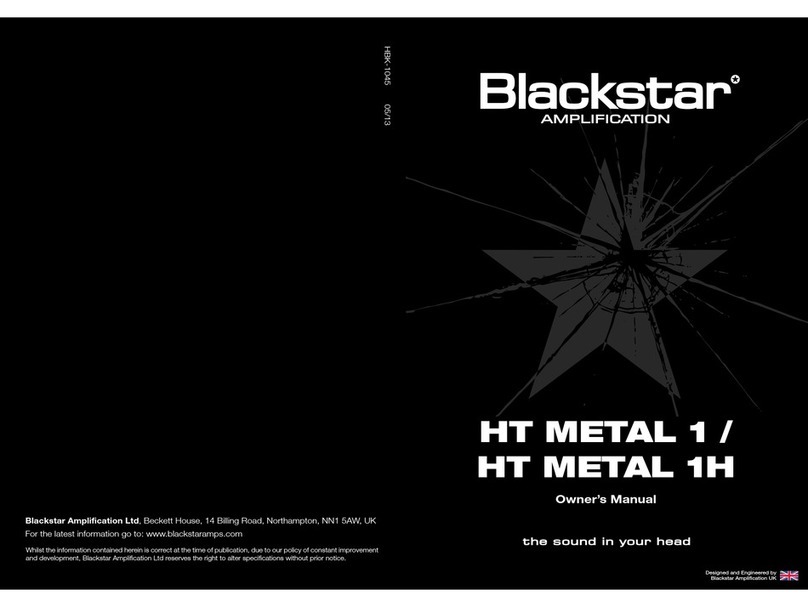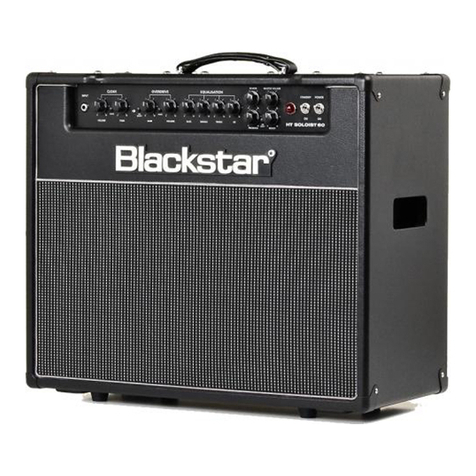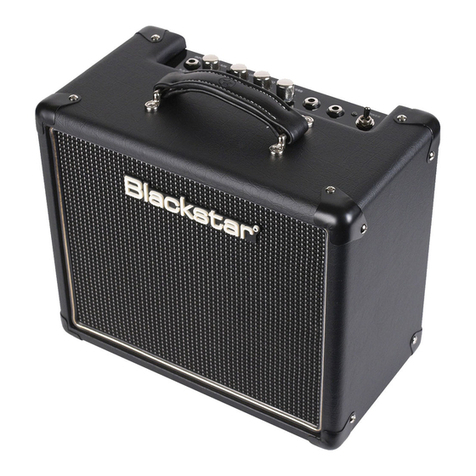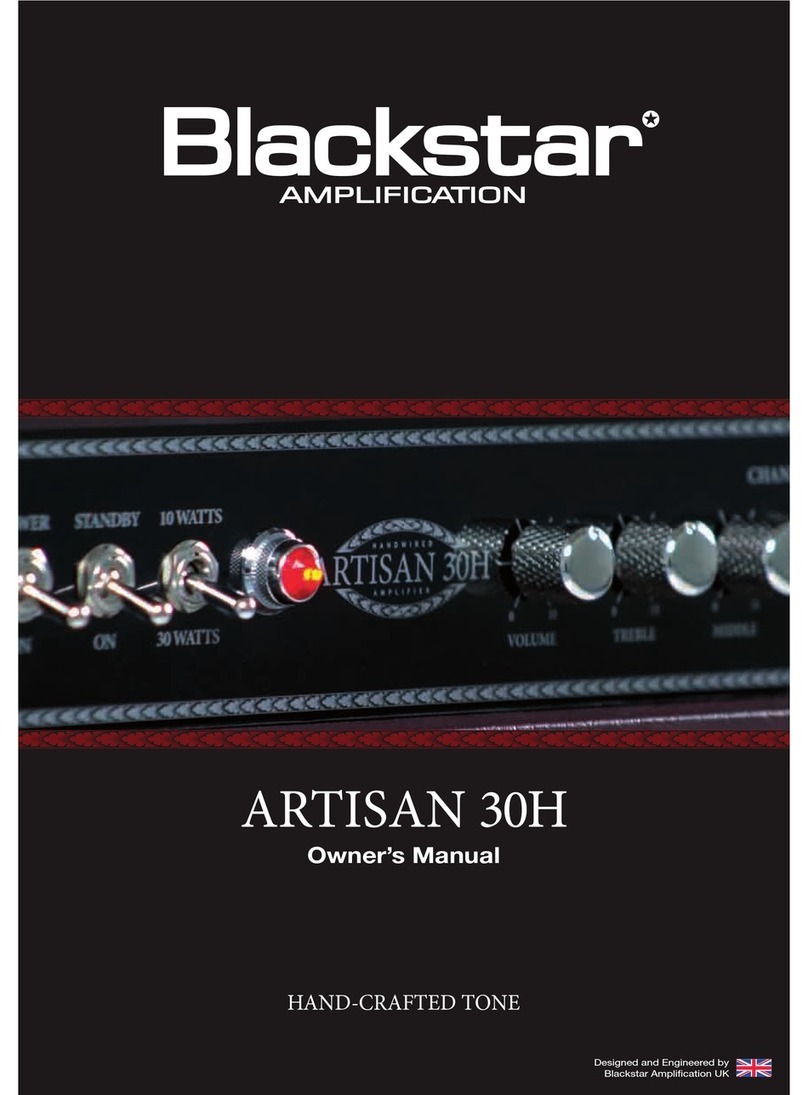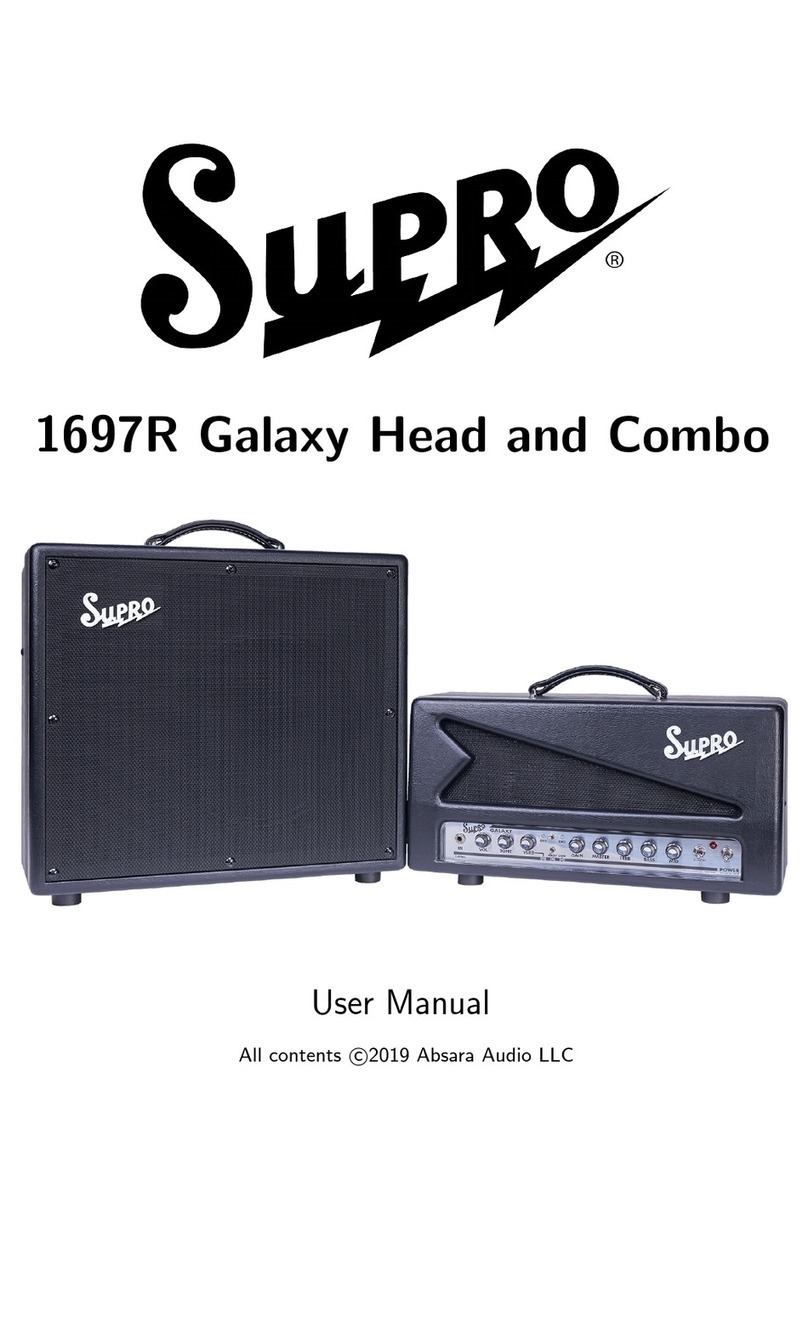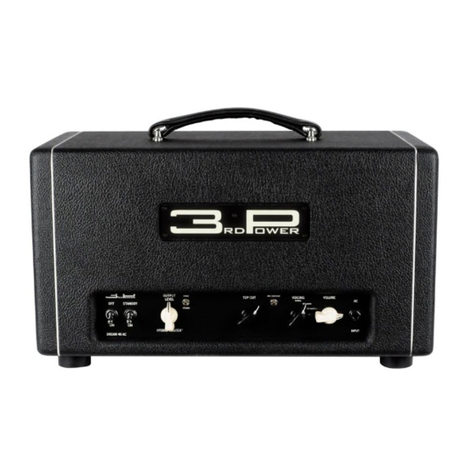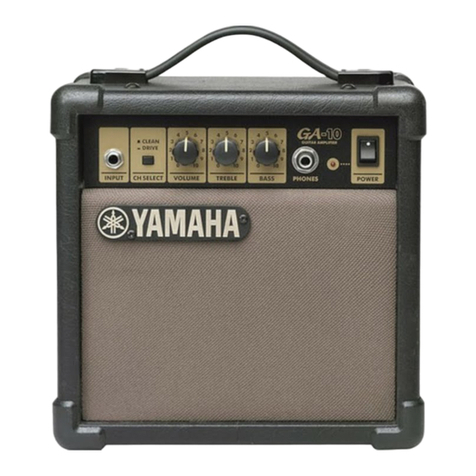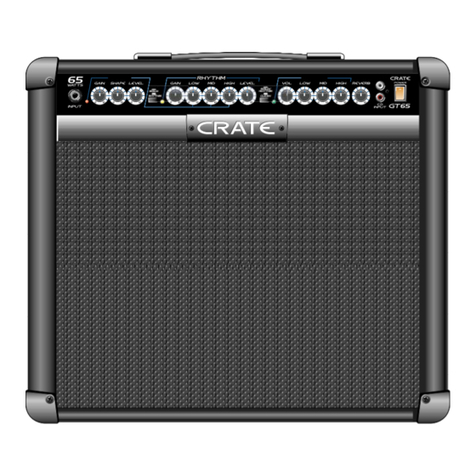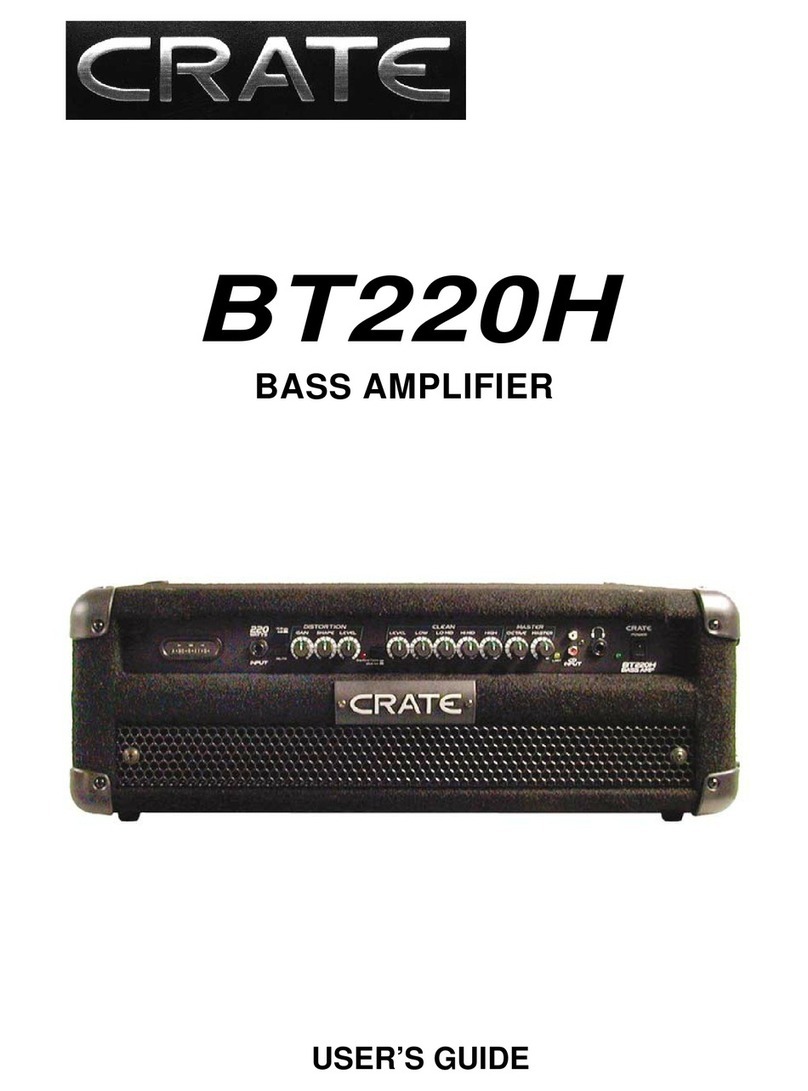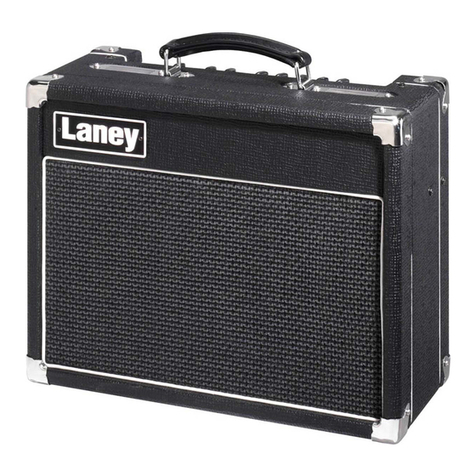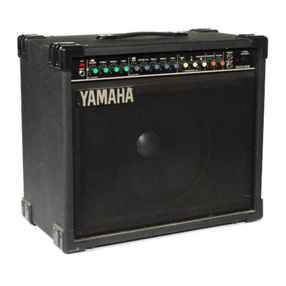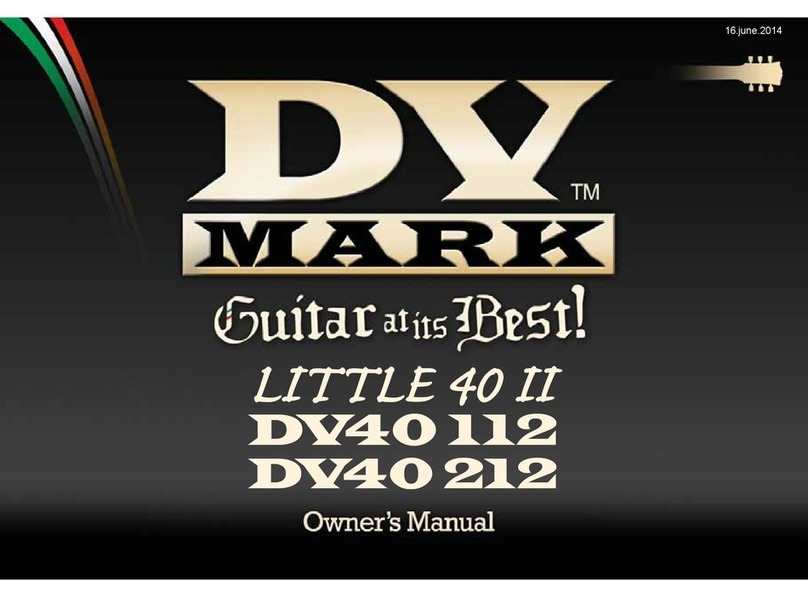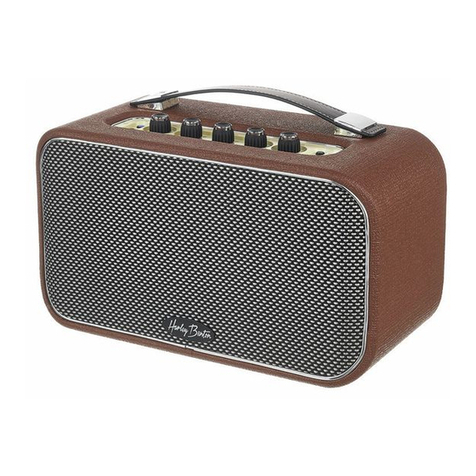BLACK STAR S1-100 User manual

1
Blackstar Amplification Ltd, Beckett House, 14 Billing Road, Northampton, NN1 5AW, UK
For the latest information go to: www.blackstaramps.com
Whilst the information contained herein is correct at the time of publication, due to our policy of constant improvement
and development, Blackstar Amplification Ltd reserves the right to alter specifications without prior notice.
Designed and Engineered by
Blackstar Amplification UK
Owner’s Manual
HBK-1016 01/09

3
USA / Canada
IMPORTANT SAFETY INSTRUCTIONS
1. Read these instructions.
2. Keep these instructions.
3. Heed all warnings.
4. Follow all instructions.
5. Do not use this apparatus near water.
6. Clean only with dry cloth.
7. Do not block any ventilation openings.
8. Install in accordance with the manufacturer’s instructions.
9. Do not install near any heat sources such as radiators, heat registers, stoves, or
other apparatus (including ampliers) that produce heat.
10. Do not defeat the safety purpose of the polarized or grounding-type plug. A
polarized plug has two blades with one wider than the other. A grounding type
plug has two blades and a third grounding prong. The wide blade or the third
prong are provided for your safety. If the provided plug does not t into your
outlet, consult an electrician for replacement of the obsolete outlet.
11. Protect the power cord from being walked on or pinched particularly at plugs,
convenience receptacles, and the point where they exit from the apparatus.
12. Only use attachments/accessories specied by the manufacturer.
13. Unplug this apparatus during lightning storms or when unused for long periods
of time.
14. Refer all servicing to qualied service personnel. Servicing is required when the
apparatus has been damaged in any way, such as the power-supply cord or plug
is damaged, liquid has been spilled or objects have fallen into the apparatus, the
apparatus has been exposed to rain or moisture, does not operate normally, or
has been dropped.
“TO COMPLETELY DISCONNECT THIS APPARATUS FROM THE AC MAINS,
DISCONNECT THE POWER SUPPLY CORD PLUG FROM THE AC RECEPTACLE”.
“WARNING: TO REDUCE THE RISK OF FIRE OR ELECTRIC SHOCK, DO NOT
EXPOSE THIS APPARATUS TO RAIN OR MOISTURE AND OBJECTS FILLED WITH
LIQUIDS, SUCH AS VASES, SHOULD NOT BE PLACED ON THIS APPARATUS”.
This symbol is intended to alert the user to the presence of important operation
and maintenance (servicing) instructions in the literature accompanying the
appliance.
This symbol is intended to alert the user to the presence of uninsulated
“dangerous voltage” within the product’s enclosure that may be of sufcient
magnitude to constitute a risk of electric shock to persons.

54
Warning!
Important safety information!
READ THE FOLLOWING INFORMATION CAREFULLY. SAVE ALL
INSTRUCTIONS FOR FUTURE REFERENCE!
Follow all warnings and instructions marked on the product!
Danger! High internal operating voltages.
Do not open the equipment case. There are no user serviceable parts in this
equipment. Refer all servicing to qualied service personnel.
Clean only with a dry cloth.
Condensation can form on the inside of an amplier if it is moved from a cold
environment to a warmer location. Before switching the unit on, it is recommended
that the unit be allowed to reach room temperature.
Unauthorised modication of this equipment is expressly forbidden by Blackstar
Amplication Ltd.
Never push objects of any kind into ventilation slots on the equipment casing.
Do not expose this apparatus to rain, liquids or moisture of any type.
Do not place this product on an unstable trolley, stand or table. The product may
fall, causing serious damage to the product or to persons!
Do not cover or block ventilation slots or openings.
This product should not be placed near a source of heat such as a stove, radiator,
or another heat producing amplier.
Use only the supplied power cord which is compatible with the mains voltage
supply in your area.
Power supply cords should always be handled carefully and should be replaced if
damaged in any way.
Never break off the earth (ground) pin on the power supply cord.
The power supply cord should be unplugged when the unit is to be unused for long
periods of time.
Before the unit is switched on, the loudspeaker should be connected as described
in the handbook using the lead recommended by the manufacturer.
Always replace damaged fuses with the correct rating and type.
Never disconnect the protective mains earth connection.
High loudspeaker levels can cause permanent hearing damage. You should
therefore avoid the direct vicinity of loudspeakers operating at high levels. Wear
hearing protection if continuously exposed to high levels.
If the product does not operate normally when the operating instructions are
followed, then refer the product to a qualied service engineer.
The U.S. Government´s Occupational Safety and Health Administration (OSHA) has
specied the following permissible noise level exposures:
Duration Per Day In Hours Sound Level dBA, Slow Response
8 90
6 92
4 95
3 97
2 100
1½ 102
1 105
½ 110
¼ or less 115
According to OSHA, any exposure in excess of the above permissible limits could
result in some hearing loss.
Ear plug protectors in the ear canals or over the ears must be worn when operating
this amplication system in order to prevent permanent hearing loss if exposure is
in excess of the limits as set forth above. To ensure against potentially dangerous
exposure to high sound pressure levels, it is recommended that all persons exposed
to equipment capable of producing high sound pressure levels such as this
amplication system be protected by hearing protectors while this unit is in operation.
English
English
All electrical and electronic products should be disposed of separately
from the municipal waste stream via designated collection facilities
appointed by the government or the local authorities.

76
Introduction
Thank you for purchasing this Blackstar Series One amplier. Like all our
products, this amp is the result of countless hours of painstaking Research and
Development by our world-class design team. Based in Northampton (UK), the
Blackstar team are all experienced musicians themselves and the sole aim of
the development process is to provide guitarists with products which are the
ultimate tools for self-expression.
All Blackstar products are subjected to extensive laboratory and road testing to
ensure that they are truly uncompromising in terms of reliability, quality and above
all TONE.
The S1-100’s highly exible two channel, 4 mode design features the unique
Patented DPR (Dynamic Power Reduction) and Patented ISF (Innite Shape
Feature) controls and although it has a comprehensive control set, it is still simple
and intuitive to use. Please read through this handbook carefully to ensure you get
the maximum benet from your new Blackstar product.
If you like what you hear and want to nd out more about the Blackstar range of
products please visit our website at www.blackstaramps.com.
Thanks!
The Blackstar Team
Features
The S1-100 sees the distillation of decades of guitar amplier design experience
into the ultimate 100W valve head. Every control has been honed for maximum
sonic benet through hundreds of hours of listening.
The S1-100 Clean Channel sets the precedent for no-compromise design, by
featuring Bright and Warm modes. Each mode actually recongures the pre-
amplier voicing and power amplier damping to reproduce either ringing Class A
performance in the Bright mode, or crunchy Class AB tones in the Warm setting.
Careful attention was paid to the levels of overdrive available when designing the
S1-100. Crunch mode covers the widest range of crunch gain levels possible from
just on the edge clean break-up, to crushing modern rhythm tones. Super Crunch
mode alters both gain levels and tonal shaping for maximum crunch exibility.
The overdrive modes are characterised by a tone which is high in gain, but lacks
any of the detached top-end often found in many similar designs. This is a result of
unique preamplier and power amplier shaping techniques, which also benet the
player in the way the overdrives clean up beautifully as the guitar volume is reduced.
Even at the most extreme settings, the overdrive channels remain natural sounding.
The Patented ISF control is unique to Blackstar Amplication and represents a
major step forward in tone shaping exibility. The ISF control shifts the response of
the three control tone stack between at one end a US response and at the other,
a UK response. Importantly, an innite number of alternative tone choices lie in
between that would be otherwise unavailable.
Completing the tonal feature set is another unique Patented Blackstar innovation
– the DPR (Dynamic Power Reduction) system. DPR reduces the power of the
output stage from full power (100W) down to 10% (10W) and any power output in
between. This means that the full tonal depth of the EL34 power amplier can be
enjoyed at any volume, making the S1-100 ideal for recording, smaller gigs and
even home practice use. Working in conjunction with the power amplier voltages,
this method of power reduction suffers none of the loss in tone of other power
reduction systems.
The tonal exibility of the S1-100 is augmented by full MIDI implementation of the
main channel and mode switching functions. Used in conjunction with outboard gear
such as multi-effects units, MIDI allows a whole new level of creative performance
to be explored.
English
English

98
Front Panel
1. Input
Plug your guitar in here. Always use a good quality screened guitar lead.
Clean Channel
2. Bright Clean Mode Indicator
When the green LED is on Bright Clean Mode is selected.
3. Bright Clean Mode Select
Press this switch to select the Bright Clean Mode.
4. Warm Clean Mode Indicator
When the yellow LED is on Warm Clean Mode is selected.
5. Warm Clean Mode Select
Press this switch to select the Warm Clean Mode.
6. Clean Gain
The Clean Gain control adjusts the amount of the Clean Channel’s overdrive or
distortion. Low settings, counter clockwise, will deliver a clean sound. As the Clean
Gain control is increased clockwise the sound will begin to break-up, delivering a
subtle overdrive.
7. Clean Volume
This controls the volume of the Clean Channel. Turning it clockwise increases the
volume.
The Bright and Warm modes recongure both preamplier and power amplier
circuits to deliver Class A or Class AB style tones.
The table below describes the operation of the two modes:
English
English
Overdrive Channel
8. Crunch Mode Indicator
When the orange LED is on Crunch Mode is selected.
9. Crunch Mode Select
Press this switch to select Crunch Mode.
10. Super Crunch Mode Indicator
When the red LED is on Super Crunch Mode is selected.
11. Super Crunch Mode Select
Press this switch to select Super Crunch Mode.
12. Overdrive Gain
The Overdrive Gain control adjusts the amount of the Overdrive Channel’s overdrive or
distortion. Low settings, counter clockwise, will deliver a clean sound on the edge of
break-up. As the Overdrive Gain control is increased clockwise the sound will become
more overdriven, moving through beautiful crunch tones until, at its maximum position,
a full distorted tone is arrived at.
13. Overdrive Volume
This controls the volume of the Overdrive Channel. Turning it clockwise increases
the volume.
Equalisation
14. Bass
The Bass control adjusts the amount of low-end frequencies in your tone. This amp
has an advanced tone shaping circuit which allows the tone to be tight and cutting,
counter clockwise, to warm and thumping, clockwise.
15. Middle
The Middle control adjusts the amount of middle frequencies in your tone. The middle
frequencies are particularly important in setting the amount of ‘body’ your tone has.
With the Middle control set to its minimum position (fully counter clockwise) the sound
will be aggressive and scooped, a tone ideal for aggressive rhythm playing. As the
Middle control is increased (clockwise) the amount of ‘body’ is increased, which is
more suitable for sustained lead guitar tones.
Mode Preamp Character Power Amp Damping Use For
Bright Clean Tighter bass, chiming mids Low (greater emphasis Ringing clean and
and highs on lows and highs) jangly rhythm
Warm Clean Looser bass, glassy highs Medium (tighter Warm cleans and crunchy
bottom-end for crunch) rhythms

1110
English
English
16. Treble
The Treble control allows exact adjustment of the treble frequencies within the
sound. At low settings (counter clockwise) the sound will be warm and darker in
character. As the Treble control is increased (clockwise) the sound will become
brighter. At the maximum settings the sound will be aggressive and cutting.
17. ISF (Innite Shape Feature)
The ISF control works in conjunction with the Bass,
Middle and Treble controls. It allows you to choose
the exact tonal signature you prefer. Fully counter
clockwise has a more American characteristic with a
tight bottom-end and more aggressive middle, and
fully clockwise has a British characteristic which is
more ‘woody’ and less aggressive.
Unlike conventional ‘contour’ controls and parametric equalisation systems, the Bass,
Middle and Treble controls remain interactive with each other just like in a traditional
guitar amplier tone stack. This leads to a very familiar, musical response.
Master
18. Resonance
The Resonance control sets the overall bass response of the S1-100. At lower
settings the cleans will be tight and funky and overdrives will be focussed in their
bass response. At increased settings the clean sounds will be become full and
warm, whilst the crunch and overdrive tones will be more bass heavy and resonant.
19. Presence
The Presence control sets the overall treble response of the S1-100. Percussive
high-end can be accentuated on clean sounds and the amount of aggressive treble
controlled with crunch and overdrive settings.
20. Volume
This controls the overall volume of your amplier. Turning it clockwise increases the
volume.
21. DPR (Dynamic Power Reduction)
The DPR control allows the output power of the S1-100 to be
reduced anywhere from 100W (100%) down to 10W (10%) of
the rated power.
DPR works by controlling the power supply voltages to the EL34
output valves and also the level of drive signal into the power
amplier stage. Importantly, there are no components placed
in between the output valves, the output transformer and the
loudspeaker – a relationship which is essential in the delivery of
valve tone.
In addition to reducing the output power of the S1-100, the DPR system actually
controls the amount of power amplier compression too. Power amplier
compression is a key ingredient in the characteristics of low powered valve amplier
tone and gives a very playable ‘feel’ to the S1-100 at reduced power settings.
We would recommend experimenting with the channel Gain and Volume, Master
Volume and DPR Control to achieve various combinations of preamplier and power
amplier distortion / compression.
Note: Generally speaking the more DPR is applied (i.e. power is reduced) the more
dynamic compression and power amp clipping will be experienced at any given
volume.
Clean DPR Operation
The DPR control is extremely powerful in ne-tuning the exact dynamic compression
characteristics of the power amplier.
Channel Channel Channel Master DPR Description/Sound Character
Gain Volume Volume
Clean Low Mid Mid High Maximum pre and power amplier
headroom yields extremely dynamic
clean sounds.
Clean Low High High Low Increasing drive to the power
amplier and reducing output power
gives a compressed clean sound rich in
power amplier induced harmonics.
Clean High High High Low Higher channel gain further increases
the power amplier drive producing
a ‘full stack’ crunch tone at only 10W
output power.
Overdrive DPR Operation
The DPR control allows you to pin-point exactly how much valve overdrive you want
to come from the preamplier section and how much is coming from the EL34s in
the power amplier section.
Channel Channel Channel Master DPR Description/Sound Character
Gain Volume Volume
Clean Low/Mid Mid Mid High Lower gain settings provide a dynamic
crunch utilising the full 100W of
available headroom.
Clean Low High High Low At these settings there is a blend of the
distortion and compression generated
in the preamplier and power amplier
valves. We recommend that you
experiment to nd your ‘sweet-spot’.
Clean High High High Low Here maximum preamplier gain is
combined with the lowest power
amplier output for maximum valve
saturation.
US
AU
K

1312
English
English
22. Power Indicator Light
The power indicator will light when the amplier is switched on.
23. Standby
This switch applies the H.T. (High Tension) voltage required to produce sound to
the output stage. Always turn this switch on at least 30 seconds after the Power
switch (24). During short breaks in playing use just this switch to turn ‘off’ and ‘on’ the
amplier’s output.
24. Power
This switch is used to turn the amplier on and off. You should always turn this switch
on before turning on the Standby switch (23).
MIDI Channel Switching
The Series One offers the ability to control channel selection via MIDI Program Change
messages and interfacing with most MIDI controllers is a straight forward process.
The Series One can be placed in a MIDI chain allowing you to simultaneously select a
channel on the amplier and change the patch on a MIDI effects processor connected
to the effects loop. There are 128 available Program Changes, giving you the possibility
to access a vast number of tonal combinations.
To set-up MIDI channel switching, simply connect the MIDI controller’s MIDI Out
socket to the MIDI In socket on the rear of the amplier. The controller should be set
to transmit Program Change messages (this is usually the case). From new, a Series
One amplier is set to OMNI mode and responds to Program Change messages
on all MIDI channels. Changing ‘patches’ on the controller will change the selected
channel on the amp. The default settings for each Program Change number are
shown in the table below:
Program Channel
Change
Program Change Assignment
To change the default assignments and set the amp up to respond to a different set
of Program Changes:
1. The amp must be powered on with either the Standby switch set to on, a jack
in the Input socket, or both.
2. Send the appropriate Program Change message to the amp.
3. Press and hold in the appropriate front panel Channel Select switch for 2
seconds.
The corresponding channel will be selected and its LED will ash three times in
quick succession to indicate it has been assigned to the last received Program
Change. The amplier will now remember the selection. Repeat the operation until
all your Program Changes have the desired amp channel assigned to them.
MIDI Receive Channel Selection
As mentioned previously, the default mode is set to OMNI and will respond to MIDI
Program Changes on all MIDI channels. You may wish to set the amp to respond
to Program Changes on just a single MIDI channel. The Series One can be set to
respond in this way for any of the rst seven MIDI channels as follows:
1. The unit must be in standby (Power (24) on and Standby (23) off), and no lead
connected to the Input jack.
2. Simultaneously press and hold the Bright Clean (3) and Crunch (9) Select switches.
3. After 2 seconds the LED for Super Crunch (10) will begin to ash continuously (2
ashes per second) to indicate that the unit is in MIDI Receive Channel Program
Mode.
4. Release the Bright Clean (3) and Crunch (9) Select switches and select the
required MIDI channel by using the Channel Select switches as shown in the
table below:
Bright Clean Warm Clean Crunch MIDI CHANNEL
OFF OFF OFF OMNI
ON OFF OFF 1
OFF ON OFF 2
ON ON OFF 3
OFF OFF ON 4
ON OFF ON 5
OFF ON ON 6
ON ON ON 7
The corresponding Channel Select LEDs will illuminate to show the selection and
each press of the Channel Select switches will toggle the state of its associated
LED.
1 BRIGHT CLEAN
2 WARM CLEAN
3 CRUNCH
4 SUPER CRUNCH
5 BRIGHT CLEAN
6 WARM CLEAN
7 CRUNCH
8 SUPER CRUNCH
9 BRIGHT CLEAN
10 WARM CLEAN
11 CRUNCH
12 SUPER CRUNCH
13 BRIGHT CLEAN
14 WARM CLEAN
15 CRUNCH
16 SUPER CRUNCH
17 BRIGHT CLEAN
18 WARM CLEAN
19 CRUNCH
20 SUPER CRUNCH
21 BRIGHT CLEAN
22 WARM CLEAN
23 CRUNCH
24 SUPER CRUNCH
25 BRIGHT CLEAN
26 WARM CLEAN
27 CRUNCH
28 SUPER CRUNCH
29 BRIGHT CLEAN
30 WARM CLEAN
31 CRUNCH
32 SUPER CRUNCH
33 BRIGHT CLEAN
34 WARM CLEAN
35 CRUNCH
36 SUPER CRUNCH
37 BRIGHT CLEAN
38 WARM CLEAN
39 CRUNCH
40 SUPER CRUNCH
41 BRIGHT CLEAN
42 WARM CLEAN
43 CRUNCH
44 SUPER CRUNCH
45 BRIGHT CLEAN
46 WARM CLEAN
47 CRUNCH
48 SUPER CRUNCH
49 BRIGHT CLEAN
50 WARM CLEAN
51 CRUNCH
52 SUPER CRUNCH
53 BRIGHT CLEAN
54 WARM CLEAN
55 CRUNCH
56 SUPER CRUNCH
57 BRIGHT CLEAN
58 WARM CLEAN
59 CRUNCH
60 SUPER CRUNCH
61 BRIGHT CLEAN
62 WARM CLEAN
63 CRUNCH
64 SUPER CRUNCH
65 BRIGHT CLEAN
66 WARM CLEAN
67 CRUNCH
68 SUPER CRUNCH
69 BRIGHT CLEAN
70 WARM CLEAN
71 CRUNCH
72 SUPER CRUNCH
73 BRIGHT CLEAN
74 WARM CLEAN
75 CRUNCH
76 SUPER CRUNCH
77 BRIGHT CLEAN
78 WARM CLEAN
79 CRUNCH
80 SUPER CRUNCH
81 BRIGHT CLEAN
82 WARM CLEAN
83 CRUNCH
84 SUPER CRUNCH
85 BRIGHT CLEAN
86 WARM CLEAN
87 CRUNCH
88 SUPER CRUNCH
89 BRIGHT CLEAN
90 WARM CLEAN
91 CRUNCH
92 SUPER CRUNCH
93 BRIGHT CLEAN
94 WARM CLEAN
95 CRUNCH
96 SUPER CRUNCH
97 BRIGHT CLEAN
98 WARM CLEAN
99 CRUNCH
100 SUPER CRUNCH
101 BRIGHT CLEAN
102 WARM CLEAN
103 CRUNCH
104 SUPER CRUNCH
105 BRIGHT CLEAN
106 WARM CLEAN
107 CRUNCH
108 SUPER CRUNCH
109 BRIGHT CLEAN
110 WARM CLEAN
111 CRUNCH
112 SUPER CRUNCH
113 BRIGHT CLEAN
114 WARM CLEAN
115 CRUNCH
116 SUPER CRUNCH
117 BRIGHT CLEAN
118 WARM CLEAN
119 CRUNCH
120 SUPER CRUNCH
121 BRIGHT CLEAN
122 WARM CLEAN
123 CRUNCH
124 SUPER CRUNCH
125 BRIGHT CLEAN
126 WARM CLEAN
127 CRUNCH
128 SUPER CRUNCH

1514
5. To store the desired selection press the Super Crunch (11) Select switch. The
Super Crunch Select LED (10) will ash quickly four times when the operation is
complete. The unit will then revert to normal operation, and will respond only to
Program Changes on the newly selected MIDI Channel.
MIDI Dump Out
You may wish to back up the MIDI channel select settings so you can transfer them
to another amplier, for example. To do this you will need a MIDI Sysex librarian,
which is usually a piece of software running on a PC or MAC with a suitable MIDI
interface.
1. The unit must be in standby (Power (24) on and Standby (23) off), with no
lead connected to the Input jack and the MIDI Thru on the rear of the amplier
connected to the MIDI In of the MIDI interface.
2. Simultaneously press and hold the Warm Clean (5) and Super Crunch (11)
Select switches. After 2 seconds the LED for Crunch (8) will ash continuously
to indicate that the unit is in MIDI Dump Mode.
3. Prepare the receiving equipment for the transfer. For example, if using a MIDI
Sysex librarian this must be put into le receive mode.
4. Start the le transfer by pressing and quickly releasing the Crunch (9) Select
switch. During the le transfer the Crunch Select LED (8) will ash quickly. When
the ashing stops the transfer operation is complete and the amplier will revert
to normal operation. The le should be saved as a MIDI System Exclusive le.
MIDI Dump In
To load in previously saved Program Change assignments:
1. Connect the MIDI Out of the MIDI recording device to the MIDI In on the rear of
the amplier and use the MIDI Sysex librarian to send the previously stored MIDI
System Exclusive le.
The amplier overwrites the current Program Change assignments with the new
ones. If the operation completes successfully all four channel LEDs ash quickly four
times. If the dump is unsuccessful or incomplete the four LEDs will ash slowly in an
alternating pattern and then the unit will revert to normal operation.
Note: During reception of the System Exclusive le the amplier will temporarily
cease to pass data to the MIDI Thru socket.
Restoring Factory Settings
To return the amplier to its factory default state:
1. With the amplier Power off, press and hold in the Warm Clean (5) and Super
Crunch (11) Select switches.
2. While holding in the switches turn on the amplier. After 2 seconds all channel
select LEDs ash once to conrm the factory defaults have been restored.
Rear Panel
1. Mains Input
The supplied detachable mains lead is connected here. The lead should only
be connected to a power outlet that is compatible with the voltage, power and
frequency requirements stated on the rear panel. If in doubt get advice from a
qualied technician.
2. Mains Fuse
The value of the Mains Fuse is specied on the rear panel. Never use a fuse of the
incorrect value or attempt to bypass it.
3. H.T. Fuse
The value of the H.T. Fuse is specied on the rear panel. Never use a fuse of the
incorrect value or attempt to bypass it.
4. Footswitch
The supplied footswitch is connected here. The footswitch enables you to switch
between the Bright Clean, Warm Clean, Crunch and Super Crunch modes.
5. MIDI Thru
Any MIDI data received at the MIDI In socket is passed out of the MIDI Thru socket
so that other MIDI devices can be placed in a chain. The MIDI Thru socket also
serves as a way of dumping Channel Select/Program Change data to a suitable
MIDI storage device. Refer to the MIDI Channel Switching section for more details.
Always use a good quality MIDI lead.
6. MIDI In
If channel switching using MIDI is required, connect the MIDI device here. Refer
to the MIDI Channel Switching section for more details. Always use a good quality
MIDI lead.
EFFECTS LOOPEMULATED OUTPUT
FOOTSWITCH
RETURN SEND
LEVEL
+4dBV
-10dBV
4Ω16Ω
8Ω
MIDI
THRU IN
SPEAKER OUTPUTS
H.T. FUSEMAINS INPUT MAINS FUSE
T1AL 250V
230V/240V - T2AL 250V
100V/120V - T5AL 250V
100V~50/60Hz
300 WATTS
CONNECT SPEAKERS BEFORE USE
OUTPUT: 100 WATTS RMS
MODEL: S1-100
WARNING!: RISK OF HAZARDOUS ENERGY
AVIS!: ENERGIE ELECTRIQUE DANGEREUSE!
WARNING!: SHOCK HAZARD. DO NOT OPEN. TO REDUCE THE RISK OF FIRE OR ELECTRIC SHOCK
DO NOT EXPOSE THIS EQUIPMENT TO RAIN OR MOISTURE. THIS APPARATUS MUST BE EARTHED.
AVIS!: RISQUE DE CHOC ELECTRIQUE. NE PAS OUVRIR. POUR EVITER LES RISQUES D’INCENDIE ET
DE DECHARGES ELECTRIQUES, N’EXPOSEZ JAMAIS CET APPAREIL A L’ HUMIDITE OU A LA PLUIE.
CONNECTER CET APPAREIL A LA TERRE.
This device complies with Part 15 of the FCC Rules. Operation is subject to thefollowing two
conditions: (1) this device may not cause harmful interference, and (2) this device must accept
any interference received, including interference that may cause undesired operation.
This Class B digital apparatus complies with Canadian ICES-003.
Cet appareil numérique de la classe B est conforme à la norme NMB-003 du Canada.
CAUTION!: TO REDUCE THE RISK OF ELECTRIC SHOCK DO NOT REMOVE COVER. NO USER
SERVICEABLE PARTS INSIDE. REFER SERVICING TO QUALIFIED SERVICE PERSONNEL.
ATTENTION!: POUR EVITER LES RISQUES DE DECHARGES ELECTRIQUES, NE PAS OUVRIR LE
COUVERCLE. CET APPAREIL NE COMPORTE AUCUNE PIECE SUSCEPTIBLE D’ETRE REPAREE PAR
VOS SOINS. FAITES TOUJOURS APPEL A UN TECHNICIEN QUALIFIE POUR TOUTE REPARATION.
WARNING!: DO NOT OBSTRUCT VENTILATION GRILLES
ATTENTION!: NE PAS OBSTRUER LES GRILLES DE VENTILATION
Blackstar Amplification Ltd
Designed and Engineered by
Northampton, England
IMPEDANCE
N16549
1 2 10 119123 4 5 6 7 8
English
English

1716
7. Impedance Selector
This control matches the amplier’s impedance to that of the connected speakers.
Always ensure that the selected impedance matches that of the speaker cabinets
connected. See table below.
Cabinets Connected Impedance Selected
1 x 16 Ohm cabinet 16 Ohms
2 x 16 Ohm cabinets 8 Ohms
1 x 8 Ohm cabinet 8 Ohms
2 x 8 Ohm cabinets 4 Ohms
1 x 4 Ohm cabinet 4 Ohms
A speaker cabinet of less than 4 Ohms, or 2 x 4 Ohm cabinets, should not be used
together with this amplier.
WARNING: The amplier must always be completely powered down before
adjusting the setting of the Impedance Selector. Failure to do this, or to correctly
match the impedance of the amplier and speakers, will damage the amplier.
8. Speaker Outputs
There are two parallel speaker outputs for connecting external speaker cabinets.
When connecting speakers always ensure that the Impedance Selector (7) is set
correctly.
9. Speaker Emulated Output
This output emulates the tonal characteristics of a guitar speaker cabinet and
provides a natural valve overdrive tone for connection to a recording device or
mixing desk. Always use a good quality screened lead. There is both a jack and a
balanced XLR output.
NOTE: To ‘silently’ record, turn the amp to standby mode. You may also record
from this output while in standby mode without a loudspeaker connected, but
ensure that no loudspeaker leads are connected to either of the loudspeaker output
jack sockets of the amplier, as this will defeat the load protection circuit and cause
damage to the amplier.
10. Effects Loop Level
The Effects Loop Level switch sets the effects loop to either +4dBV/-10dBV, which
enables you to use it with either professional equipment (+4dBV setting), or with
guitar level effects such as effects pedals (-10dBV setting).
11. Effects Loop Return
Connect the (mono) output of an external effects unit here.
12. Effects Loop Send
Connect the (mono) input of an external effects unit here.
Technical Specication
Power (RMS): 100 Watts
Valves: 4 x EL34, 3 x ECC83, 1 x ECC82
Weight (kg): 23.2
Dimensions (mm): 705 x 285 x 278.5
Footswitch: FS-2 supplied
English
English

1918
Deutsch
Deutsch
Alle Elektro- und Elektronik-Altgeräte müssen getrennt vom Hausmüll
über dafür staatlich vorgesehenen Stelen entsorgt werden.
Wichtige Informationen zur Sicherheit!
LESEN SIE DIE FOLGENDEN INFORMATIONEN SORGFÄLTIG DURCH.
BEWAHREN SIE ALLE ANLEITUNGEN FÜR DIE ZUKÜNFTIGE
BEZUGNAHME AUF
Befolgen Sie alle auf dem Produkt ausgewiesenen Warnungen und
Anleitungen!
Gefahr! Hohe interne Betriebsspannungen
Öffnen Sie nicht das Gehäuse des Geräts. Es benden sich keine vom Anwender
zu wartende Teile in diesem Gerät. Überlassen Sie alle Servicearbeiten qualiziertem
Wartungspersonal.
Nur mit einem trockenen Lappen reinigen
Auf der Innenseite eines Verstärkers kann sich Kondensationsnässe bilden, wenn er
von einer kalten Umgebung an einen wärmeren Ort bewegt wird. Es wird empfohlen,
dass das Gerät vor dem Einschalten Zimmertemperatur erreicht.
Unerlaubte Änderungen an diesem Gerät sind ausdrücklich von Blackstar
Amplication Ltd verboten.
Stecken Sie niemals Objekte jeglicher Art in die Lüftungsschlitze des Gehäuses.
Setzen Sie dieses Gerät nicht Regen, Flüssigkeiten oder Feuchtigkeit jeglicher Art
aus.
Befolgen Sie alle auf dem Produkt ausgewiesenen Warnungen und Anleitungen!
Platzieren Sie dieses Produkt nicht auf einem instabilen Rollwagen, Ständer oder
Tisch. Das Produkt kann herunterfallen und dem Produkt oder Personen ernsthaften
Schaden zufügen!
Blockieren oder verdecken Sie nicht die Lüftungsschlitze oder -öffnungen.
Dieses Produkt sollte nicht in der Nähe einer Wärmequelle wie einem Ofen,
Heizkörper oder einem anderen Hitze entwickelnden Verstärker platziert werden.
Verwenden Sie nur das zum Lieferumfang gehörende Netzkabel, das mit der
Netzstromversorgung in Ihrer Region kompatibel ist.
Netzkabel müssen stets mit Vorsicht gehandhabt und ersetzt werden, wenn sie in
irgendeiner Weise beschädigt werden.
Brechen Sie niemals den Erdungsstift (Erde) am Netzkabel ab.
Das Netzkabel sollte aus der Steckdose gezogen werden, wenn das Gerät längere
Zeit nicht verwendet wird.
Bevor das Gerät eingeschaltet wird, muss der Lautsprecher entsprechend der
Beschreibung im Handbuch unter Verwendung des vom Hersteller empfohlenen
Kabels angeschlossen werden.
Ersetzen Sie beschädigte Sicherungen stets mit der korrekten Spannung und Art.
Trennen Sie niemals die schützende Netz/Erde-Verbindung.
Hohe Lautsprecherpegel können permanente Hörschäden verursachen. Sie sollten
daher die direkte Nähe zu Lautsprechern, die auf hohen Pegeln betrieben werden,
vermeiden. Tragen Sie einen Hörschutz, wenn Sie kontinuierlich hohen Pegeln
ausgesetzt sind.
Wenn das Produkt nicht normal funktioniert, während die Betriebsanleitung befolgt
wird, übergeben Sie das Produkt an einen qualizierten Servicetechniker.
Die Verwaltung zur Gesundheit und Sicherheit am Arbeitsplatz der US-Regierung
(OSHA) hat die folgenden zulässigen Lärmpegelbelastungen festgelegt:
Dauer pro Tag in Stunden Lärmpegel dBA, Langsame Reaktion
8 90
6 92
4 95
3 97
2 100
1½ 102
1 105
½ 110
¼ oder weniger 115
Laut der OSHA kann jede Belastung oberhalb der oben genannten zulässigen
Grenzwerte zu gewissen Hörverlusten führen.
Wenn dieses Verstärkersystem betrieben wird, müssen Ohrschützer im Ohrkanal
oder über den Ohren getragen werden, um permanenten Hörverlust zu vermeiden,
wenn die Belastung oberhalb der oben festgelegten Grenzwerte liegt. Um sich
gegen potenziell gefährliche Belastungen durch hohe Schalldruckpegel zu schützen,
wird empfohlen, dass alle Personen, die Geräten wie diesem Verstärkersystem
ausgesetzt sind, die in der Lage sind, hohe Schalldruckpegel zu entwickeln,
während des Betriebs dieses Geräts durch Ohrschützer geschützt werden.

2120
Einleitung
Vielen Dank, dass Sie sich für den Blackstar Series One Verstärker entschieden
haben. Dieser Amp ist wie alle unsere Verstärker das Ergebnis unzähliger Stunden
akribischer Arbeit durch unser erstklassiges Entwickler-Team. Blackstar hat seinen
Sitz in Northampton (UK) und setzt sich aus einem Team erfahrener Musiker
zusammen, die nur ein Ziel verfolgen: Gitarristen mit den Werkzeugen zu versorgen,
die ihnen dabei helfen, sich selbst zu verwirklichen.
Alle Blackstar-Produkte wurden sowohl in unseren Labors als auch im Live-Betrieb
auf Herz und Nieren getestet, um sicherzustellen, dass sie in punkto Zuverlässigkeit,
Qualität und KLANG absolut kompromisslose Ergebnisse liefern.
Das hochexible Design des S1-100 mit zwei Kanälen und vier Modi zeichnet
sich zusätzlich durch die einzigartigen DPR- (Dynamic Power Reduction) und
ISF-Schaltungen (Innite Shape Feature) aus. Dabei bleibt der Verstärker trotz
umfangreicher Regelmöglichkeiten stets einfach und intuitiv zu bedienen. Bitte lesen
Sie dieses Handbuch aufmerksam durch, um Ihr neues Blackstar-Produkt optimal
nutzen zu können.
Wenn Sie mehr über die Blackstar-Produktreihe erfahren möchten, besuchen Sie
unsere Webseite unter www.blackstaramps.com.
Vielen Dank!
Das Blackstar-Team
Merkmale
Im S1-100 haben wir jahrzehntelange Erfahrung in der Entwicklung von
Gitarrenverstärkern in dem ultimativen 100-Watt-Röhren-Topteil umgesetzt. Jeder
Regler wurde in unzähligen Stunden intensiven Hörens auf maximale Klanggüte
getrimmt.
Der Clean-Kanal des S1-100 ist ein gutes Beispiel für absolut kompromissloses
Design und bietet einen Bright- sowie einen Warm-Modus. Jeder Modus stellt
tatsächlich das jeweilige Vorverstärker-Voicing und die Endstufen-Dämpfung nach,
um die kraftvolle Class-A-Performance im Bright-Modus oder die crunchigen Class-
AB-Sounds in der Betriebsart Warm zu erzeugen.
Besondere Sorgfalt wurde während der Entwicklungsphase des S1-100 auf die
verfügbaren Overdrive-Stufen gelegt. Der Crunch-Modus deckt den Bereich aller
möglichen Crunch-Gain-Settings von clean-knackigen Sounds bis hin zu drückend-
modernen Rhythmus-Parts ab. Im Super-Crunch-Modus ändern sich sowohl die
Gain-Settings als auch das tonale Shaping, wodurch Sie eine maximale Flexibilität
im Bereich von Crunch-Sounds erzielen.
Die Overdrive-Modi zeichnen sich durch einen Sound aus, der ausreichend Gain-
Reserven bietet, jedoch kein übermäßiges Top-End liefert, wie man es von ähnlichen
Schaltungsdesigns kennt. Das ist das Ergebnis der einzigartigen Shaping-Techniken
in der Vor- und Endstufe: Dabei werden Sie als Gitarrist sicher zu schätzen wissen,
dass Sie allein mit Hilfe des Volume-Potis zwischen Overdrive- und wunderschönen
Clean-Sounds variieren können. Selbst bei extremen Einstellungen klingt der
Overdrive-Kanal immer natürlich und offen.
Die von Blackstar Amplication für ein Patent angemeldete ISF-Regelung ist
einzigartig und stellt einen großen Fortschritt in Bezug auf eine exible Klangregelung
dar. Der ISF-Regler erlaubt es, die Klangfarbe der Klangregelung mit ihren drei
Reglern zwischen einem US- und einem UK-typischen Charakter zu variieren.
Natürlich liegen zwischen diesen beiden Charakteristika unendlich viele andere
Klangfärbungen, die bei anderen Verstärkern denitiv nicht zur Verfügung stehen.
Komplettiert wird das Klangspektrum durch eine weitere, von Blackstar zum Patent
angemeldete Neuerung – das DPR-System (Dynamic Power Reduction). DPR senkt
die Leistung der Ausgangsstufe von 100 % (100W) stufenlos auf bis zu 10% (10W)
ab. Das bedeutet, dass Sie den Druck und die Klangtiefe der EL34-Ausgangsstufe
bei jeder beliebigen Lautstärke nutzen können, wodurch sich der S1-100 bestens
für Aufnahmen, kleinere Gigs oder auch das Üben zuhause empehlt. Da diese
Schaltung direkt mit der Spannungsversorgung der Endstufe zusammenarbeitet,
treten bei diesem Verfahren keine Klangverluste auf, wie man sie von anderen
Systemen zur Leistungsreduktion kennt.
Die akustische Vielfalt des S1-100 wird durch eine komplette MIDI-Implementation
zur Umschaltung des Hauptkanals sowie des Modus vervollständigt. In Verbindung
mit anderen Outboard-Geräten wie Multi-Effekten eröffnet Ihnen MIDI so völlig neue
kreative Möglichkeiten.
Deutsch
Deutsch

2322
Vorderseite
1. Eingang
Hier schließen Sie Ihre Gitarre an. Verwenden Sie in jedem Fall hochwertige
geschirmte Gitarrenkabel.
Clean-Kanal
2. Anzeige für den Modus Bright Clean
Wenn die grüne LED leuchtet, ist der Modus Bright Clean aktiv.
3. Wahlschalter für den Modus Bright Clean
Drücken Sie diesen Schalter, um den Modus Bright Clean anzuwählen.
4. Anzeige für den Modus Warm Clean
Wenn die gelbe LED leuchtet, ist der Modus Warm Clean aktiv.
5. Wahlschalter für den Modus Warm Clean
Mit diesem Schalter wählen Sie den Modus Warm Clean an.
6. Clean Gain
Mit dem Gain-Regler steuern Sie den Übersteuerungs- oder Verzerrungsgrad im
Clean-Kanal. Niedrige Einstellungen (gegen den Uhrzeigersinn) sorgen für einen
cleanen Sound. Wenn Sie den Regler Clean Gain im Uhrzeigersinn aufdrehen, steigt
die Übersteuerung bis hin zu zu einem dezenten Overdrive-Sound an.
7. Clean Volume
Mit diesem Regler steuern Sie die Lautstärke im Clean-Kanal. Im Uhrzeigersinn
heben Sie die Lautstärke an.
In den Modi Bright und Warm werden sowohl der Vorverstärker als auch die
Endstufe so konguriert, dass sie wahlweise typische Class-A- oder Class-AB-
Sounds erzeugen.
In der folgenden Tabelle ist der Betrieb der beiden Modi beschrieben:
Betriebsart Preamp-Charakter Endstufen-Dämpfung Geeignet für
Bright Clean Knackige Bässe, offene Gering (Bässe und Höhen Durchdringende Clean- und
Mitten und Höhen werden stärker betont) treibende Rhythmus-Sounds
Warm Clean Weniger Bässe, Mittel (knackiges Warme Clean- und Crunch-
glockige Höhen Fundament für Crunch- Rhythmus-Sounds
Sounds)
Overdrive-Kanal
8. Anzeige für den Modus Crunch
Wenn die orange LED leuchtet, ist der Modus Warm Crunch aktiv.
9. Wahlschalter für den Modus Super Crunch
Mit diesem Schalter wählen Sie den Modus Crunch an.
10. Anzeige für den Modus Super Crunch
Wenn die rote LED leuchtet, ist der Modus Super Crunch aktiv.
11. Anzeige für den Modus Super Crunch
Mit diesem Schalter wählen Sie den Modus Super Crunch an.
12. Overdrive Gain
Mit dem Overdrive-Gain-Regler steuern Sie den Übersteuerungs- oder Verzerrungsgrad
im Overdrive-Kanal. Niedrige Einstellungen (gegen den Uhrzeigersinn) liefern einen
cleanen Sound mit viel Druck und Durchsetzungsvermögen. Wenn der Overdrive-
Gain-Regler aufgedreht wird (im Uhrzeigersinn), nimmt der Verzerrungsgrad mehr
und mehr zu und wechselt von crunchigen Sounds bis hin zu stark verzerrten
Sounds in der Extremposition.
13. Overdrive Volume
Mit diesem Regler steuern Sie die Lautstärke im Overdrive-Kanal. Im Uhrzeigersinn
heben Sie die Lautstärke an.
Klangregelung
14. Bass
Der Bass-Regler steuert den Anteil der Bassfrequenzen im Gesamt-Sound. Dieser
Verstärker bietet eine umfangreiche Klangregelung, mit der Sie den Ton zwischen
Deutsch
Deutsch

2524
knackig und aggressiv (gegen den Uhrzeigersinn) oder warm und druckvoll (im
Uhrzeigersinn) einstellen können.
15. Middle
Der Mitten-Regler steuert den Anteil der Mittenfrequenzen im Gesamt-Sound. Die
Mitten sind insbesondere für den Grundsound entscheidend. In der Minimalposition
(komplett gegen den Uhrzeigersinn) ist der Sound sehr aggressiv und hohl, was sich
speziell für knackige Rhythmus-Parts eignet. Wenn der Mitten-Regler angehoben
wird (im Uhrzeigersinn), nimmt der Grundton-Anteil zu, was sich für singende Lead-
Gitarren-Sounds empehlt.
16. Treble
Mit dem Regler Treble können Sie gezielt der Höhenanteil im Gesamt-Sound
einstellen. Bei niedrigen Einstellungen (gegen den Uhrzeigersinn) erhält der Sound
einen wärmeren und dumpferen Charakter. Wenn der Treble-Regler angehoben
wird (im Uhrzeigersinn), wird der Sound immer höhenreicher. In der Maximalposition
klingt der Sound schließlich aggressiv und schneidend.
17. ISF (Innite Shape Feature)
Der ISF-Regler arbeitet mit den Reglern für Bass,
Middle und Treble zusammen. Mit seiner Hilfe nden
Sie genau die Klangfärbung, die Sie suchen. Bei
Einstellungen gegen den Uhrzeigersinn besitzt der
Amp einen “amerikanischen” Sound-Charakter mit
einem knackigen Bassfundament und aggressiveren
Mitten. Bei Einstellungen im Uhrzeigersinn erzeugt der
Amp einen “britischen” Sound, der deutlich ‘erdiger
und weniger aggressiv klingt.
Im Gegensatz zu herkömmlichen Contour-Reglern und parametrischen EQ-
Systemen beeinussen sich die Regler für Bass, Middle und Treble gegenseitig - so
wie man das aus klassischen Gitarrenverstärker-Stacks her kennt. Das führt letztlich
zu einem vertrauten, musikalischen Verhalten.
Master
18. Resonance
Mit dem Regler Resonance steuern Sie die grundlegende Basswiedergabe des
S1-100. Bei niedrigen Einstellungen klingen cleane Sounds knackig und funky,
während bei angezerrten Sounds die Basswiedergabe angehoben wird. Bei
höheren Einstellungen klingen Clean-Sounds voll und warm, während sich Crunch-
und Overdrive-Sounds durch wuchtige Bässe und Druck auszeichnen.
19. Presence
Mit dem Regler Presence steuern Sie die grundlegende Höhenwiedergabe des S1-
100. Perkussive Höhen werden bei cleanen Sounds betont, aggressive Höhen lassen
sich bei Crunch- und Overdrive-Sounds gezielt steuern.
20. Volume
Dieser Regler steuert die Gesamtlautstärke Ihres Verstärkers. Im Uhrzeigersinn heben
Sie die Lautstärke an.
21. DPR (Dynamic Power Reduction)
Mit dem DPR-Regler können Sie die Ausgangsleistung des S1-100 stufenlos im
Bereich von 100W (100%) bis hinunter auf 10W (10%) der angegebenen Leistung
drosseln.
DPR regelt die Versorgungsspannung der EL34-Ausgangsröhren und
zudem den Pegel des Drive-Signals, der auf die Endstufe gespeist wird.
Dabei werden keine zusätzlichen Komponenten in den Signaluss zwischen
Ausgangsröhren, Ausgangsübertrager und Lautsprecher geschaltet - was
extrem wichtig ist, um den typischen Röhrensound zu erhalten.
Neben der Reduktion der Ausgangsleistung des S1-100 steuert das
DPR-System zudem die Kompression in der Ausgangsstufe. Diese
Endstufen-Kompression ist ein Hauptmerkmal der Klangcharakteristik
bei pegelbegrenzten Röhrenverstärker-Sounds und sorgt beim S1-100
für ein sehr authentisches ‚Spielgefühl’ bei reduzierter Leistungsabgabe.
Wir empfehlen Ihnen, mit den Reglern für Gain und Volume im Kanal, dem
Master Volume sowie dem DPR-Regler zu experimentieren, um die unterschiedlichen
Kombinationen aus Vor- und Endverstärker-Übersteuerung/Sättigung kennenzulernen.
Anmerkung: Grundsätzlich gilt, dass höhere Werte für DPR (und damit eine
reduzierte Leistung) für eine höhere dynamische Sättigung und Übersteuerung der
Endstufe in der aktuellen Lautstärke sorgen.
DPR im Clean-Betrieb
Mit dem DPR-Regler lässt sich die dynamische Kompression der Endstufe extrem
genau einstellen.
Kanal Kanal Kanal Master DPR Beschreibung/Klangcharakter
-Gain -Volume Volume
Clean Niedrig Mittel Mittel Hoch Ein maximaler Headroom bei der
Vor- und Endstufe sorgt für extrem
dynamische Clean-Sounds.
Clean Niedrig Hoch Hoch Niedrig Durch eine stärkere Ansteuerung
der Endstufe bei reduzierter
Ausgangsleistung entsteht ein
komprimierter Clean-Sound mit vielen
harmonischen, für Röhrenverstärker
typischen Obertönen.
Clean Hoch Hoch Hoch Niedrig Höhere Gain-Werte im Kanal steuern
die Endstufe stärker an und sorgen so
für einen vollwertigen ‚Stack’-Crunch-
Sound bei nur 10 W Ausgangsleitung.
US
AU
K
Deutsch
Deutsch

2726
DPR im Overdrive-Betrieb
Mit dem DPR-Regler können Sie exakt bestimmen, wie viel Röhrenverzerrung in
der Vorstufe erzeugt wird und wie stark zudem die EL34-Röhren in der Endstufe
übersteuert werden.
Kanal Kanal Kanal Master DPR Beschreibung/Klangcharakter
-Gain -Volume Volume
Crunch Niedrig/ Mittel Mittel Hoch Niedrigere Gain-Settings sorgen für
Mittel einen dynamischen Crunch-Sound, der
den verfügbaren Headroom von 100 W
ausnutzt.
Crunch Mittel Hoch Hoch Mittel In diesen Settings entsteht eine
Mischung aus Distortion- und
Kompression-Sounds, die mit den
Röhren der Vor- und Endstufe erzeugt
werden. Experimentieren Sie selbst
und nden Sie so Ihren ‚Sweet-Spot’.
Crunch Hoch Mittel Mittel Niedrig Hierbei wird das maximele Gain der
Vorstufe mit der minimalen Leistung
der Endstufe kombiniert: Das Ergebnis
ist die maximale Röhrensättigung.
22. Power-Leuchte
Die Power-Kontrollleuchte ist aktiv, wenn Sie den Verstärker einschalten.
23. Standby
Mit diesem Schalter wird die H.T.- (High Tension) Spannung angelegt, die zur
Verstärkung in der Ausgangsstufe benötigt wird. Schalten Sie den Standby frühestens
30 Sekunden nach dem Power-Schalter (24) ein. Während kurzer Spielpausen können
Sie den Verstärkerausgang mit diesem Schalter an- und abschalten.
24. Power
Mit diesem Schalter schalten Sie den Verstärker ein bzw. aus. Aktivieren Sie diesen
Schalter in jedem Fall vor dem Standby-Schalter (23).
Kanalumschaltung über MIDI
Der Series One bietet die Möglichkeit, die Kanalwahl über MIDI-
Programmwechselbefehle zu steuern und kann entsprechend direkt mit den
meisten MIDI-Controllern betrieben werden. Der Series One kann in eine MIDI-
Kette integriert werden, wodurch Sie beispielsweise zeitgleich einen Kanal am
Verstärker auswählen und ein Patch in einem MIDI-Effektprozessor umschalten
können, der an der Effektschleife angeschlossen ist. Über die 128 verfügbaren
Programmwechselbefehle können Sie auf unendlich viele Klangoptionen zugreifen.
Um die Kanalumschaltung via MIDI einzurichten, müssen Sie lediglich die Buchse
MIDI Out am MIDI-Controller mit der Buchse MIDI In auf der Rückseite des
Verstärkers verbinden. Zudem müssen Sie den Controller so einstellen dass der
Programmwechselbefehle ausgibt (was normalerweise der Fall ist). Ein Series-One-
Verstärker ist nach dem Auspacken auf den OMNI-Modus eingestellt und reagiert
daher auf Programmwechselbefehle auf allen MIDI-Kanälen. Durch Auswahl eines
‚Patches’ am Controller wird der entsprechende Kanal am Verstärker aktiviert.
Die Voreinstellungen für jeden Programmwechselbefehl nden Sie in der Liste unten:
Programm Kanal
-wechsel
1 BRIGHT CLEAN
2 WARM CLEAN
3 CRUNCH
4 SUPER CRUNCH
5 BRIGHT CLEAN
6 WARM CLEAN
7 CRUNCH
8 SUPER CRUNCH
9 BRIGHT CLEAN
10 WARM CLEAN
11 CRUNCH
12 SUPER CRUNCH
13 BRIGHT CLEAN
14 WARM CLEAN
15 CRUNCH
16 SUPER CRUNCH
17 BRIGHT CLEAN
18 WARM CLEAN
19 CRUNCH
20 SUPER CRUNCH
21 BRIGHT CLEAN
22 WARM CLEAN
23 CRUNCH
24 SUPER CRUNCH
25 BRIGHT CLEAN
26 WARM CLEAN
27 CRUNCH
28 SUPER CRUNCH
29 BRIGHT CLEAN
30 WARM CLEAN
31 CRUNCH
32 SUPER CRUNCH
33 BRIGHT CLEAN
34 WARM CLEAN
35 CRUNCH
36 SUPER CRUNCH
37 BRIGHT CLEAN
38 WARM CLEAN
39 CRUNCH
40 SUPER CRUNCH
41 BRIGHT CLEAN
42 WARM CLEAN
43 CRUNCH
44 SUPER CRUNCH
45 BRIGHT CLEAN
46 WARM CLEAN
47 CRUNCH
48 SUPER CRUNCH
49 BRIGHT CLEAN
50 WARM CLEAN
51 CRUNCH
52 SUPER CRUNCH
53 BRIGHT CLEAN
54 WARM CLEAN
55 CRUNCH
56 SUPER CRUNCH
57 BRIGHT CLEAN
58 WARM CLEAN
59 CRUNCH
60 SUPER CRUNCH
61 BRIGHT CLEAN
62 WARM CLEAN
63 CRUNCH
64 SUPER CRUNCH
65 BRIGHT CLEAN
66 WARM CLEAN
67 CRUNCH
68 SUPER CRUNCH
69 BRIGHT CLEAN
70 WARM CLEAN
71 CRUNCH
72 SUPER CRUNCH
73 BRIGHT CLEAN
74 WARM CLEAN
75 CRUNCH
76 SUPER CRUNCH
77 BRIGHT CLEAN
78 WARM CLEAN
79 CRUNCH
80 SUPER CRUNCH
81 BRIGHT CLEAN
82 WARM CLEAN
83 CRUNCH
84 SUPER CRUNCH
85 BRIGHT CLEAN
86 WARM CLEAN
87 CRUNCH
88 SUPER CRUNCH
89 BRIGHT CLEAN
90 WARM CLEAN
91 CRUNCH
92 SUPER CRUNCH
93 BRIGHT CLEAN
94 WARM CLEAN
95 CRUNCH
96 SUPER CRUNCH
97 BRIGHT CLEAN
98 WARM CLEAN
99 CRUNCH
100 SUPER CRUNCH
101 BRIGHT CLEAN
102 WARM CLEAN
103 CRUNCH
104 SUPER CRUNCH
105 BRIGHT CLEAN
106 WARM CLEAN
107 CRUNCH
108 SUPER CRUNCH
109 BRIGHT CLEAN
110 WARM CLEAN
111 CRUNCH
112 SUPER CRUNCH
113 BRIGHT CLEAN
114 WARM CLEAN
115 CRUNCH
116 SUPER CRUNCH
117 BRIGHT CLEAN
118 WARM CLEAN
119 CRUNCH
120 SUPER CRUNCH
121 BRIGHT CLEAN
122 WARM CLEAN
123 CRUNCH
124 SUPER CRUNCH
125 BRIGHT CLEAN
126 WARM CLEAN
127 CRUNCH
128 SUPER CRUNCH
Programmwechsel-Zuordnung
So ändern Sie die vorgegebenen Zuordnungen und stellen den Verstärker ein, so
dass er auf andere Programmwechselbefehle reagiert:
1. Der Verstärker muss eingeschaltet sein. Zusätzlich muss der Standby-Schalter
(23) auf ON gestellt und/oder ein Kabel an der Input-Buchse eingesteckt sein.
2. Geben Sie den gewünschten Programmwechselbefehl an den Verstärker aus.
3. Drücken und halten Sie den gewünschten Kanalwahlschalter auf der Front für 2
Sekunden.
Der zugehörige Kanal wird angewählt und seine LED blinkt dreimal kurz hintereinander:
Das zeigt, dass er dem zuletzt empfangenen Programmwechselbefehl zugeordnet
wurde. Der Verstärker wird sich diese Verknüpfung nun merken. Wiederholen Sie
diesen Vorgang, bis alle gewünschten Programmwechsel den jeweiligen Kanälen
am Amp zugewiesen sind.
Deutsch
Deutsch

2928
Auswahl des MIDI-Empfangskanals
Wie erwähnt ist die Voreinstellung OMNI: Der Verstärker empfängt also MIDI-
Programmwechsel auf allen MIDI-Kanälen. Vielleicht möchten Sie den Verstärker
aber so einstellen, dass er nur auf Programmwechsel auf einem bestimmten MIDI-
Kanal reagiert. Der Series One kann folgendermaßen auf einen der ersten sieben
MIDI-Kanäle eingestellt werden:
1. Das Gerät muss auf Standby (Power (24) ist aktiv, Standby (23) inaktiv) geschaltet
sein. Zudem darf kein Kabel an der Eingangsbuchse angeschlossen sein.
2. Drücken und halten Sie gleichzeitig die Wahlschalter für Bright Clean (3) und
Crunch (9).
3. Nach zwei Sekunden beginnt die LED für Super Crunch (10) dauerhaft zu
blinken (zweimal pro Sekunde): Nun ist das Gerät in den Programmier-Modus
für den MIDI-Empfangskanal geschaltet.
4. Lassen Sie die Taster Bright Clean (3) und Crunch (9) los und wählen Sie den
gewünschten MIDI-Kanal wie in der Tabelle unten über die Kanalwahlschalter
aus:
Bright Clean Warm Clean Crunch MIDI-KANAL
AUS AUS AUS OMNI
AN AUS AUS 1
AUS AN AUS 2
AN AN AUS 3
AUS AUS AN 4
AN AUS AN 5
AUS AN AN 6
AN AN AN 7
Die entsprechenden Channel-Select-LEDs leuchten und zeigen so die
Auswahl an. Mit jedem Drücken der Channel-Select-Taster wird der Status der
zugehörigen LED umgeschaltet.
5. Um die gewünschte Auswahl zu speichern, lösen Sie den Wahltaster Super
Crunch (11) aus. Die zugehörige LED Super Crunch (10) blinkt daraufhin
viermal schnell, wenn der Vorgang abgeschlossen ist. Das Gerät kehrt in den
Normalbetrieb zurück und kann nun nur über Programmwechselbefehle auf
dem neu gewählten MIDI-Kanal angesprochen werden.
MIDI Dump Out
Bei Bedarf können Sie Ihre MIDI-Einstellungen extern sichern, um sie beispielsweise
auf einen anderen Verstärker zu übertragen. Dazu benötigen Sie einen MIDI-Sysex-
Librarian, der normalerweise in jeder PC- oder Mac-Software mit einem zugehörigen
MIDI-Interface enthalten ist.
1. Das Gerät muss auf Standby (Power (24) ist aktiv, Standby (23) inaktiv) geschaltet
sein. Zudem darf kein Kabel an der Eingangsbuchse angeschlossen sein und
die Buchse MIDI Thru auf der Rückseite des Verstärkers muss mit dem MIDI In
am MIDI-Interface verbunden sein.
2. Drücken und halten Sie gleichzeitig die Wahlschalter für Warm Clean (5) und
Super Crunch (11). Nach zwei Sekunden blinkt die Crunch-LED (8) dauerhaft
und zeigt so an, dass sich das Gerät im MIDI-Dump-Modus bendet.
3. Bereiten Sie das Empfangsgerät für die Übertragung vor. Bei einem MIDI-Sysex-
Librarian müssen Sie diesen beispielsweise auf Empfang schalten.
4. Starten Sie den Datentransfer, indem Sie den Wahlschalter Crunch (9) ganz kurz
drücken. Während der Datenübertragung blinkt die Crunch-LED (8) in kurzen
Abständen. Wenn die LED nicht mehr blinkt, ist der Vorgang abgeschlossen
und der Verstärker kehrt in den Normalbetrieb zurück. Die Daten sind nun als
MIDI-System-Exclusive-Datei gespeichert.
MIDI Dump In
So laden Sie extern gespeicherte Programmwechsel-Zuordnungen:
1. Verbinden Sie den MIDI Out des MIDI-Aufnahmegeräts mit dem MIDI In auf der
Rückseite des Verstärkers und verwenden Sie den MIDI-Sysex-Librarian, um die
gespeicherte MIDI-System-Exclusive-Datei auszugeben.
Der Verstärker überschreibt die aktuellen Programmwechsel-Zuordnungen mit den
neuen Daten. Wenn die Übertragung erfolgreich abgeschlossen ist, leuchten alle
vier Kanal-LEDs viermal hintereinander schnell auf. Wenn der Dump nicht oder nur
teilweise durchgeführt wurde, leuchten die vier LEDs in verschiedenen Mustern
langsam auf und das Gerät kehrt in den Normalbetrieb zurück.
Anmerkung: Während dem Empfang der System-Exclusive-Daten gibt der
Verstärker vorübergehend keine Daten über die Buchse MIDI Thru aus.
Wiederherstellen der Werkseinstellungen
So setzen Sie den Verstärker auf die Werkseinstellungen zurück:
1. Drücken und halten Sie die Auswahltaster Warm Clean (5) und Super Crunch
(11) bei ausgeschaltetem Verstärker.
2. Halten Sie die Tasten weiterhin gedrückt und schalten Sie den Verstärker ein.
Nach zwei Sekunden leuchten alle Channel-Select-LEDs einmalig auf, um das
Zurücksetzen auf die Werkseinstellungen zu bestätigen.
Deutsch
Deutsch

3130
Rückseite
1. Netzanschluss
Hier wird das mitgelieferte Kaltgerätenetzkabel angeschlossen. Das Kabel muss
an einer Netzsteckdose angeschlossen werden, die in punkto Spannung, Leistung
und Netzfrequenz den auf der Rückseite vermerkten Spezikationen entspricht. Im
Zweifelsfall wenden Sie sich an einen qualizierten Techniker/Elektriker.
2. Sicherung
Der Wert für die Sicherung ist auf der Rückseite vermerkt. Verwenden Sie in keinem
Fall eine Sicherung mit falschen Werten und versuchen Sie nicht, die Sicherung zu
umgehen.
3. H.T.- Sicherung
Der Wert für die H.T.- Sicherung ist auf der Rückseite vermerkt. Verwenden Sie
in keinem Fall eine Sicherung mit falschen Werten und versuchen Sie nicht, die
Sicherung zu umgehen.
4. Fußschalter
Hier wird der mitgelieferte Fußschalter angeschlossen. Mit dem Fußschalter können
Sie zwischen den Modi Bright Clean, Warm Clean, Crunch und Super Crunch
umschalten.
5. MIDI Thru
Alle MIDI-Daten, die an der Buchse MIDI In anliegen, werden auf die Buchse MIDI
Thru durchgeschliffen, so dass weitere MIDI-Geräte in der Kette angesteuert
werden können. Die Buchse MIDI Thru dient zudem zur Ausgabe der Kanalwahl-/
Programmwechsel-Daten auf ein geeignetes MIDI-Speichergerät. Weitere
Einzelheiten nden Sie im Abschnitt zur MIDI-Kanalumschaltung. Verwenden Sie in
jedem Fall hochwertige MIDI-Kabel.
6. MIDI In
Wenn Sie den Kanal über MIDI umschalten möchten, schließen Sie das MIDI-Gerät
hier an. Weitere Einzelheiten nden Sie im Abschnitt zur MIDI-Kanalumschaltung.
Verwenden Sie in jedem Fall hochwertige MIDI-Kabel.
7. Impedance-Wahlschalter
Mit diesem Schalter passen Sie die Impedanz des Verstärkers an den Lastwiederstand
des Lautsprechers an. Stellen Sie in jedem Fall sicher, dass die gewählte Impedanz
mit der des angeschlossenen Lautsprechers übereinstimmt. Siehe Tabelle unten.
Angeschlossene Lautsprecherboxen Gewählte Impedanz
1 Lautsprecherbox mit 16 Ohm 16 Ohm
2 Lautsprecherboxen mit 16 Ohm 8 Ohm
1 Lautsprecherbox mit 8 Ohm 8 Ohm
2 Lautsprecherboxen mit 8 Ohm 4 Ohm
1 Lautsprecherbox mit 4 Ohm 4 Ohm
Verwenden Sie keine externen Lautsprecher, deren Impedanz weniger als 4 Ohm
oder 2 x 4 Ohm beträgt.
WARNUNG: Der Verstärker muss immer vollkommen ausgeschaltet sein, bevor Sie
den Impedance-Wahlschalter verändern. Andernfalls (oder wenn die Impedanz von
Verstärker und Lautsprecher nicht übereinstimmen) können ernsthafte Schäden am
Verstärker auftreten.
8. Speaker-Ausgänge
Zum Anschluss externer Lautsprecher(-boxen) stehen zwei parallele
Lautsprecherausgänge zur Verfügung. Bevor Sie einen Lautsprecher anschließen,
stellen Sie bitte sicher, dass der Impedance-Wahlschalter (7) richtig eingestellt ist.
9. Speaker Emulated Output
Dieser Ausgang emuliert den Klangcharakter einer Gitarren-Lautsprecherbox und
sorgt in Kombination mit einem Aufnahmegerät oder Mischpult für eine natürliche
Röhren-Übersteuerung. Verwenden Sie in jedem Fall hochwertige geschirmte
Kabel. Der Ausgang kann sowohl mit Klinken- als auch symmetrischen XLR-Kabeln
belegt werden.
ANMERKUNG: Um ‚ohne Lautsprecher’ aufzunehmen, schalten Sie den Verstärker
auf Standby. Sie können diesen Ausgang auch dann zur Aufnahme verwenden,
wenn der Standby-Modus aktiv und kein Lautsprecher angeschlossen ist. Stellen
Sie jedoch sicher, dass in diesem Fall auch keine Lautsprecherkabel an einem der
Lautsprecherausgänge am Verstärker angeschlossen ist, da in diesem Fall die Last-
Schutzschaltung umgangen wird und ernsthafte Schäden am Verstärker auftreten
können.
Deutsch
Deutsch
EFFECTS LOOPEMULATED OUTPUT
FOOTSWITCH
RETURN SEND
LEVEL
+4dBV
-10dBV
4Ω16Ω
8Ω
MIDI
THRU IN
SPEAKER OUTPUTS
H.T. FUSEMAINS INPUT MAINS FUSE
T1AL 250V
230V/240V - T2AL 250V
100V/120V - T5AL 250V
100V~50/60Hz
300 WATTS
CONNECT SPEAKERS BEFORE USE
OUTPUT: 100 WATTS RMS
MODEL: S1-100
WARNING!: RISK OF HAZARDOUS ENERGY
AVIS!: ENERGIE ELECTRIQUE DANGEREUSE!
WARNING!: SHOCK HAZARD. DO NOT OPEN. TO REDUCE THE RISK OF FIRE OR ELECTRIC SHOCK
DO NOT EXPOSE THIS EQUIPMENT TO RAIN OR MOISTURE. THIS APPARATUS MUST BE EARTHED.
AVIS!: RISQUE DE CHOC ELECTRIQUE. NE PAS OUVRIR. POUR EVITER LES RISQUES D’INCENDIE ET
DE DECHARGES ELECTRIQUES, N’EXPOSEZ JAMAIS CET APPAREIL A L’ HUMIDITE OU A LA PLUIE.
CONNECTER CET APPAREIL A LA TERRE.
This device complies with Part 15 of the FCC Rules. Operation is subject to thefollowing two
conditions: (1) this device may not cause harmful interference, and (2) this device must accept
any interference received, including interference that may cause undesired operation.
This Class B digital apparatus complies with Canadian ICES-003.
Cet appareil numérique de la classe B est conforme à la norme NMB-003 du Canada.
CAUTION!: TO REDUCE THE RISK OF ELECTRIC SHOCK DO NOT REMOVE COVER. NO USER
SERVICEABLE PARTS INSIDE. REFER SERVICING TO QUALIFIED SERVICE PERSONNEL.
ATTENTION!: POUR EVITER LES RISQUES DE DECHARGES ELECTRIQUES, NE PAS OUVRIR LE
COUVERCLE. CET APPAREIL NE COMPORTE AUCUNE PIECE SUSCEPTIBLE D’ETRE REPAREE PAR
VOS SOINS. FAITES TOUJOURS APPEL A UN TECHNICIEN QUALIFIE POUR TOUTE REPARATION.
WARNING!: DO NOT OBSTRUCT VENTILATION GRILLES
ATTENTION!: NE PAS OBSTRUER LES GRILLES DE VENTILATION
Blackstar Amplification Ltd
Designed and Engineered by
Northampton, England
IMPEDANCE
N16549
1 2 10 119123 4 5 6 7 8

3332
Deutsch
Deutsch
10. Effects Loop Level
Mit dem Schalter Effects Loop Level können Sie den Effekt-Loop wahlweise mit
+4dBV oder -10dBV betreiben: Entsprechend können Sie professionelles Equipment
(Einstellung +4dBV) oder Effektpedale mit einem für Gitarren ausgelegten Pegel
(Einstellung -10dBV) anschließen.
11. Effects Loop Return
Hier schließen Sie den (Mono-)Ausgang eines externen Effektgeräts an.
12. Effects Loop Send
Hier schließen Sie den (Mono-)Eingang eines externen Effektgeräts an.
Technische Spezikationen
Leistung (RMS): 100 Watt
Röhren: 4 x EL34, 3 x ECC83, 1 x ECC82
Gewicht (kg): 23.2
Abmessungen (mm): 705 x 285 x 278.5
Fußschalter: FS-2 wird mitgeliefert

3534
Français
Français
Les éléments électriques et électroniques doivent être jetés séparément, dans les
vide-ordures prévus à cet effet par votre municipalité.
Consignes de sécurité importantes !
LISEZ LES INFORMATIONS SUIVANTES ATTENTIVEMENT. CONSERVEZ
TOUTES LES CONSIGNES POUR RÉFÉRENCE ULTÉRIEURE !
Respectez tous les avertissements et toutes les consignes gurant sur
le produit !
Danger ! Hautes tensions internes.
N’ouvrez pas le boîtier de l’appareil. Cet appareil ne possède aucune pièce sur
laquelle l’utilisateur puisse intervenir. Conez toutes les réparations à un réparateur
qualié.
Nettoyez l’appareil avec un chiffon sec uniquement.
Il est possible que de la condensation se forme à l’intérieur d’un amplicateur s’il
est transféré d’un environnement froid à un endroit plus chaud. Il est conseillé
d’attendre que l’appareil ait atteint la température ambiante avant de l’allumer.
La modication non autorisée de cet appareil est expressément interdite par
Blackstar Amplication plc.
N’introduisez jamais d’objets dans les fentes de ventilation du boîtier de l’appareil.
N’exposez pas cet appareil à la pluie, à des liquides ni à aucune forme d’humidité.
Respectez tous les avertissements et toutes les consignes gurant sur le produit !
Ne placez pas ce produit sur un chariot, un guéridon ou une table instable. Il pourrait
tomber et ce faisant sérieusement s’endommager ou causer des blessures !
Ne couvrez pas les fentes de ventilation ni les ouvertures et ne les obstruez pas
non plus.
Évitez de placer ce produit près d’une source de chaleur telle qu’un poêle, un
radiateur ou un autre amplicateur produisant de la chaleur.
Utilisez uniquement le cordon d’alimentation fourni car il est compatible avec la
tension de l’alimentation générale de votre secteur.
Manipulez toujours les cordons d’alimentation avec le plus grand soin. Remplacez-
les s’ils sont endommagés.
Ne détachez jamais la prise de terre du cordon d’alimentation.
Débranchez le cordon d’alimentation en cas d’inutilisation prolongée de l’appareil.
Avant d’allumer l’appareil, branchez l’enceinte de la manière décrite dans la notice
d’emploi à l’aide du cordon recommandé par le fabricant.
Remplacez toujours les fusibles endommagés par des fusibles du type et du calibre
appropriés.
Ne débranchez jamais la connexion à la terre de protection.
À des niveaux élevés, le volume des enceintes peut causer des pertes auditives
dénitives. Par conséquent, évitez de rester à proximité des enceintes lorsque le
volume est élevé. Portez des protecteurs d’oreilles en cas d’exposition continue à
des niveaux sonores élevés.
Si le produit ne fonctionne pas normalement alors que vous respectez la notice
d’emploi, conez-le à un réparateur qualié.
La loi américaine sur la santé et la sécurité du travail indique la durée d’exposition
autorisée à différents niveaux sonores :
Durée par jour en heures Niveau sonore (dBA), réponse lente
8 90
6 92
4 95
3 97
2 100
1½ 102
1 105
½ 110
¼ ou moins de 115
D’après cette loi, toute exposition d’une durée supérieure aux limites autorisées ci-
dessus peut entraîner une perte auditive.
Des protecteurs d’oreilles doivent être portés dans le canal auditif ou sur l’oreille
lors de l’utilisation de ce système d’amplication an d’éviter toute perte auditive
permanente si l’exposition dépasse les limites susmentionnées. An d’éviter toute
exposition potentiellement dangereuse à des niveaux de pression acoustique
élevés, il est conseillé que toutes les personnes exposées à des appareils capables
de produire des niveaux de pression acoustique élevés tels que ce système
d’amplication utilisent des protecteurs d’oreilles lors de l’utilisation de l’appareil.

3736
Introduction
Merci d’avoir acheté cet ampli Series One S1-100 de Blackstar.
Comme tous nos produits ces amplis sont le fruit du travail soigné et acharné en
Recherche et développement de notre équipe de concepteurs professionnels de
classe mondiale.
Basée à Northampton (R.-U.), l’équipe Blackstar est composée de musiciens
expérimentés. Le seul et unique objectif du développement consiste à offrir aux
guitaristes des produits qui leur permettront d’exprimer tout leur talent.
Tous les produits Blackstar sont soumis à de vastes essais en laboratoire et sur le
terrain pour s’assurer de leur qualité en termes de abilité, de qualité et surtout de
SONORITÉ !
Le Series One 100 est un ampli deux canaux polyvalent, disposant de 4 modes
et dotés des systèmes DPR (Dynamic Power Reduction) et ISF (Innite Shape
Feature), de plus il propose un panneau de contrôle compréhensible et est simple
et intuitif d’utilisation. Nous vous invitons à lire attentivement ce manuel d’utilisation
an de pouvoir proter au maximum de votre ampli Blackstar.
Si vous aimez ce que vous entendez et que vous voulez en savoir plus sur les
gammes de produits Blackstar, nous vous invitons à visiter notre site www.
blackstaramps.com.
Merci !
L’équipe Blackstar
Features
L’ampli Series One 100 regroupe des années d’expérience en termes de conception
et de fabrication en une ultime tête 100 Watts.
Chaque fonctionnalité et réglage a été conçu pour apporter le maximum de bénéce
sonore grâce à des centaines d’heure d’écoute.
La canal clair du S1-100 se positionne en référence dans sa conception sa
compromis en proposant des modes Bright et Warm bien distincts. Chaque
mode recongure la couleur tonale et le grain du préampli ET l’interaction entre le
haut-parleur et l’ampli de puissance pour reproduire soit des sonorités Classe A
cristallines en mode Bright, soit des sons crunch en mode Warm.
Une attention très particulière a été apportée aux niveaux d’overdrive lors de la
conception du S1-100. Le mode crunch couvre la totalité plage de gain, du son
clean crunchy aux puissantes sonorités rythmiques modernes.
Le mode SuperCrunch propose une conguration différente et modie les niveaux
de gains et les possibilités de réglages an de disposer d’une très grande exibilité
en matière de distortion.
Les modes Overdrive se caractérisent par des sonorities riches en gain, mais sans
les inconvénients des basses brouillonnes très souvent observées dans ce type
d’amplis. Ceci est le résultat d’une conception innovante du préampli et de l’ampli
de puissance, cela permet aussi d’avoir un overdrive qui se cleanie au fur et à
mesure que l’on diminue le volume de la guitare.
Même dans les réglages les plus extrêmes, la distorsion sonne naturelle.
Le contrôle ISF breveté par Blackstar Amplication représente véritablement un pas
en avant en terme de exibilité de son. Le réglage ISF dénit le grain de son, d’un
grain US à un grain UK mais aussi toutes les possibilités situées entre les deux et
qui n’existent sur aucun autre ampli.
Pour compléter ces possibilités tonales exemplaires, cet ampli est équipé du
système breveté DPR (Dynamic Power Reduction). Ce système dynamique de
réduction de puissance de 100% à 10% et toutes les puissances intermédiaires !
Cela signie que la présence, la réponse et la dynamique d’un ampli de puissance
à base d’EL34 peuvent être obtenues à n’importe quel volume, faisant du S1-100
un ampli idéal pour la scène mais aussi utilisable pour les enregistrements, les petits
concerts ou la pratique à domicile. Travaillant en conjonction avec les voltages de
l’ampli de puissance, cette méthode de réduction de puissance n’entraîne aucune
perte qualitative contrairement aux autres systèmes de réduction de puissance
existants sur le marché.
La exibilité tonale du S1-100 est agrémentée d’une implémentation midi totale des
fonctions de switch de canaux ou modes. Utilisée avec des effets supplémentaires,
cette implémentation Midi apporte un nouveau niveau de créativité à explorer.
Français
Français

3938
Panneau de Contrôle
1. Entrée (Input)
Branchez votre guitare ici. Utilisez toujours un son lead de bonne qualité.
Clean Channel
2. Indicateur de mode Bright Clean
Quand la diode verte est allumée, le mode Bright Clean est activé.
3. Sélecteur de mode Bright Clean
Appuyez sur ce bouton pour sélectionner le mode Bright Clean.
4. Indicateur de mode Warm Clean
Quand la diode jaune allumée, le mode Warm Clean est activé.
5. Warm Clean Mode Select
Appuyez sur ce bouton pour sélectionner le mode Warm Clean.
6. Clean Gain
Ce réglage Clean Gain permet d’ajuster le niveau d’overdrive ou de distorsion du
Canal Clean.
Réglé au minimum l’ampli délivre un son clean, en augmentant le niveau de gain le
son va commencer à saturer et va délivrer une distorsion subtile.
7. Clean Volume
Ce bouton permet de régler le volume du canal Clean. Le tourner dans le sens des
aiguilles d’une montre augmente le volume.
Les modes Bright et Warm permettent de recongurer le préampli et le circuit de
l’ampli de puissance an de délivrer des son Classe A ou Classe AB.
Le tableau ci-dessous décrit les caractéristiques des différents modes :
Mode Type de Preamp Damping de l’ampli de Utilisation
puissance
Bright Clean Peu de basses, mediums Bas (accentuation des Son clair pur et
et aigus étincelants basses et aigus) rythmiques metalliques
Warm Clean Plus de basses, aigus Medium (moins de Sons clairs chauds,
cristallins basses pour le crunch) rythmiques crunchy
Canal Overdrive
8. Indicateur de mode Crunch
Quand la diode orange est allumée, le mode Crunch est activé
9. Sélecteur de mode Crunch
Appuyez sur ce switch pour sélectionner le mode Crunch
10. Indicateur de mode Super Crunch
Quand la diode rouge est allumée, le mode Super Crunch est activé
11. Sélecteur de mode Super Crunch
Appuyez sur ce switch pour sélectionner le mode Super Crunch
12. Overdrive Gain
Le réglage Overdrive Gain permet d’ajuster le montant d’overdrive ou de distorsion
assigné à ce canal. Au minimum, il délivrera un son clair à la limite du crunch.
Lorsque que le bouton est tourné vers la droite cela augmente le Gain et le son
devient crunch, puis distordu.
13. Overdrive Volume
Ceci règle le niveau de volume du canal Overdrive.
Equalisation
14. Bass
Ce réglage permet d’ajuster le niveau de basses fréquences dans votre son. Cet
ampli dispose d’un circuit de modelage de tonalité avancé permettant d’obtenir un
son incisif et précis en réglage minimal jusqu’à un son chaud et lourd en position
maximale.
15. Middle
Ce réglage permet d’ajuster le niveau de médiums dans votre son. Ces fréquences
sont particulièrement importantes car cela dénit le ‘corps’ de votre son. Ainsi, avec
un réglage au minimal le son sera agressif et destiné à de puissantes rythmiques.
Lorsque ce réglage est tourné vers la droite le ‘corps’ du son augmente, il prend de
l’ampleur, et est plus adapté à des sons lead pleins desustain.
Français
Français
Table of contents
Languages:
Other BLACK STAR Musical Instrument Amplifier manuals
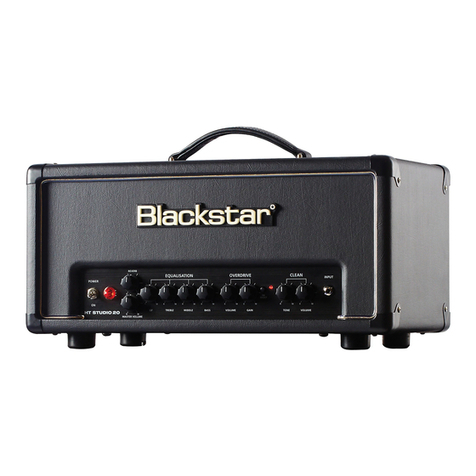
BLACK STAR
BLACK STAR HT Studio 20 Combo User manual
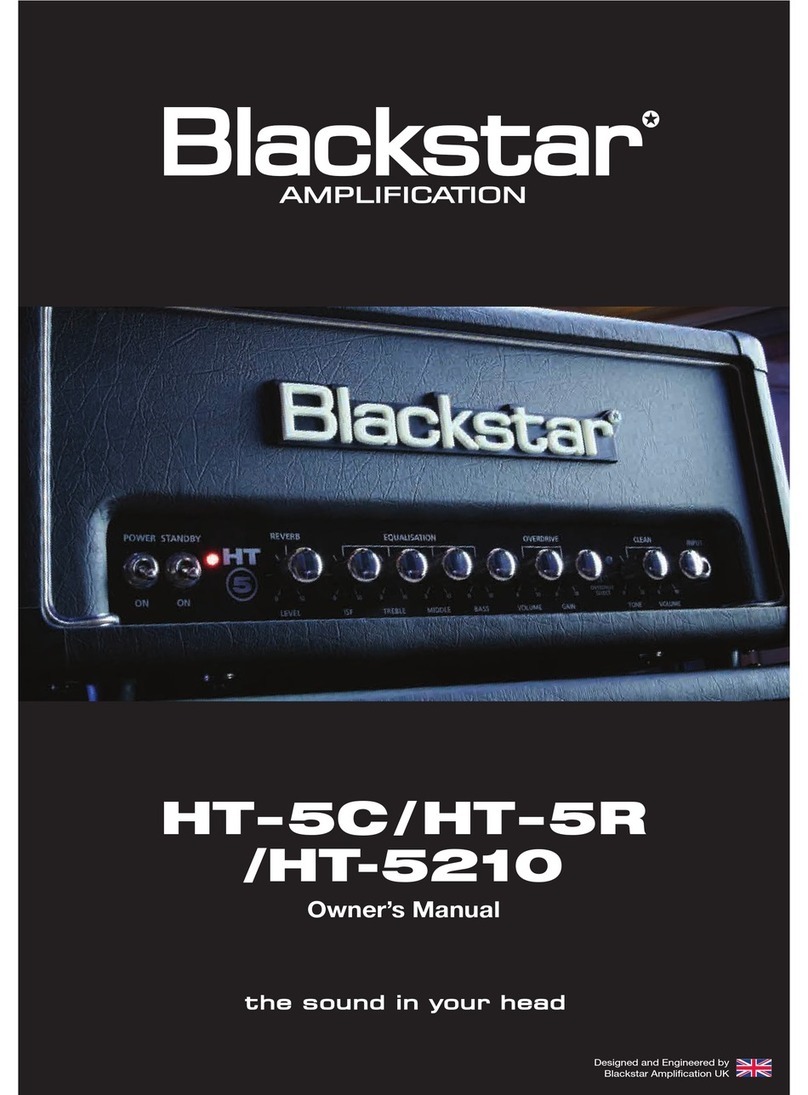
BLACK STAR
BLACK STAR HT-5C User manual

BLACK STAR
BLACK STAR HT-1 User manual

BLACK STAR
BLACK STAR ID:60TVP User manual
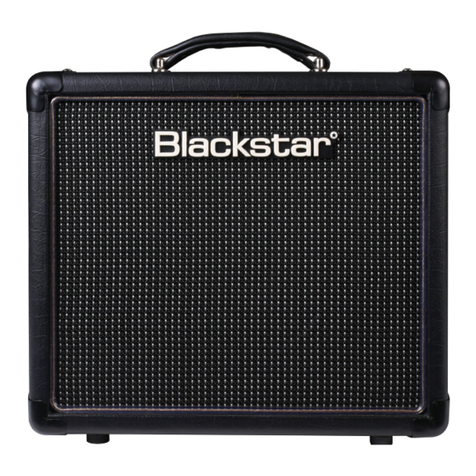
BLACK STAR
BLACK STAR HT-1R MkII User manual

BLACK STAR
BLACK STAR HT-5 User manual

BLACK STAR
BLACK STAR FLY 3 User manual
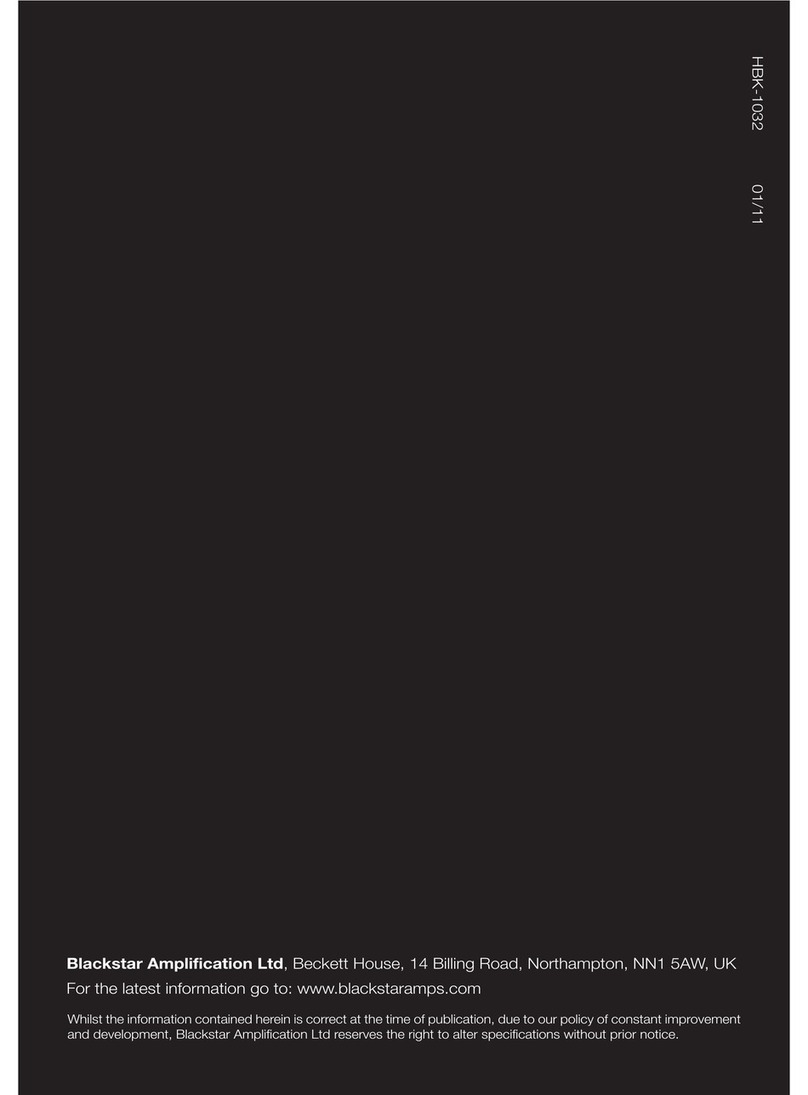
BLACK STAR
BLACK STAR S1-104EL34 User manual
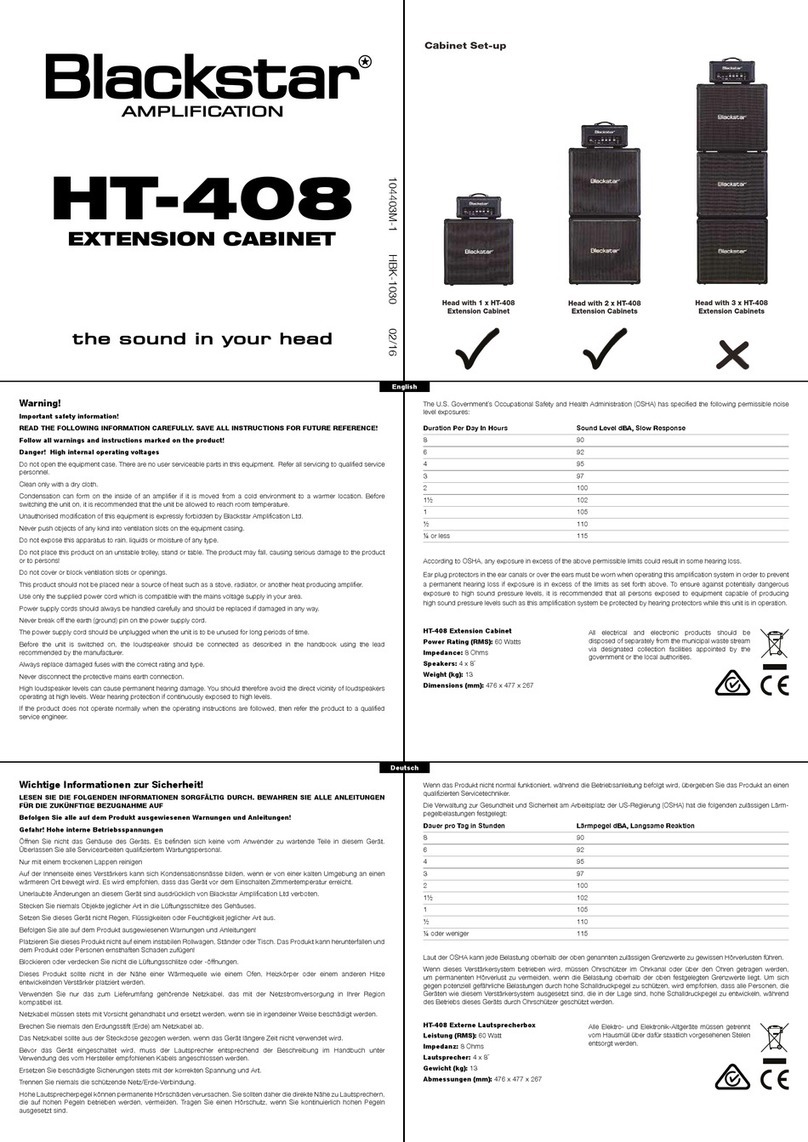
BLACK STAR
BLACK STAR HT-408 User manual

BLACK STAR
BLACK STAR Blackfire 200 User manual
